Archived Blog Posts
Steps to Keep your Family Safe with an Emergency Plan
10/15/2023 (Permalink)
Water-related emergencies can happen unexpectedly and disrupt daily life. From floods and hurricanes to burst pipes and sewer backups, it’s essential to have a family emergency plan in place to respond effectively and ensure everyone's safety. In this blog post, we will guide you through the process of creating a family emergency plan specifically tailored to water-related incidents.
Step 1: Assess the Risks
Begin by assessing the potential water-related risks in your area. Consider both natural disasters like floods and storms, as well as man-made incidents such as burst pipes or water main breaks. Research local flood zones, drainage systems, and other factors that may increase the risk of water-related emergencies.
Step 2: Establish Communication Channels
Clear communication is vital during emergencies. Establish multiple communication channels that can be used when traditional methods fail. Make sure every family member knows how to communicate via phone calls, text messages, social media, or walkie-talkies. It's also helpful to have a designated out-of-area contact whom everyone can reach in case of separation.
Step 3: Create an Evacuation Plan
If your home is at risk of flooding or other water-related disasters, create an evacuation plan. Identify safe evacuation routes and secure an alternative place to stay, such as a relative's house or a community shelter. Ensure that all family members understand the plan and know where to meet in case of separation during an evacuation.
Step 4: Assemble an Emergency Supply Kit
Prepare a well-stocked emergency supply kit specifically tailored for water-related incidents. This kit should include essentials such as bottled water, non-perishable food items, first aid supplies, flashlights, batteries, important documents, and a portable radio. Consider adding water purification tablets or a portable water filter for instances where clean water is not readily available.
Step 5: Safeguard Your Home
Take preventive measures to safeguard your home against water-related emergencies. Install flood barriers or sandbags to protect against floodwaters, ensure proper drainage around your property, and maintain your plumbing system to prevent pipe bursts. It's also beneficial to familiarize yourself with the location of shut-off valves for gas, electricity, and water.
Step 6: Educate Your Family on Safety Procedures
Educate your family about safety procedures in water-related emergencies. Teach them how to turn off the main water supply, gas valves, and electricity in case of emergencies. Make sure they know basic water safety measures, such as not touching electrical appliances in wet areas and avoiding flood waters or contaminated water.
Step 7: Practice and Review the Plan
Regularly practice your family emergency plan to ensure everyone is familiar with their roles and responsibilities. Conduct drills for evacuation, communication, and utilizing emergency supplies. Review and update the plan regularly to account for any changes in family dynamics, contact information, or community resources.
Creating a family emergency plan for water-related incidents is a crucial step in safeguarding your family's well-being during unexpected emergencies. By following these steps - assessing risks, establishing communication channels, creating an evacuation plan, assembling an emergency supply kit, safeguarding your home, educating your family on safety procedures, and practicing the plan regularly - you can be better prepared to respond effectively to water-related emergencies and ensure the safety of your loved ones. Remember, staying informed, communicating clearly, and prioritizing safety are essential in times of crisis.
Cracks in the Foundation: How Storm Damage Can Impact Your Home's Structural Stability
9/28/2023 (Permalink)
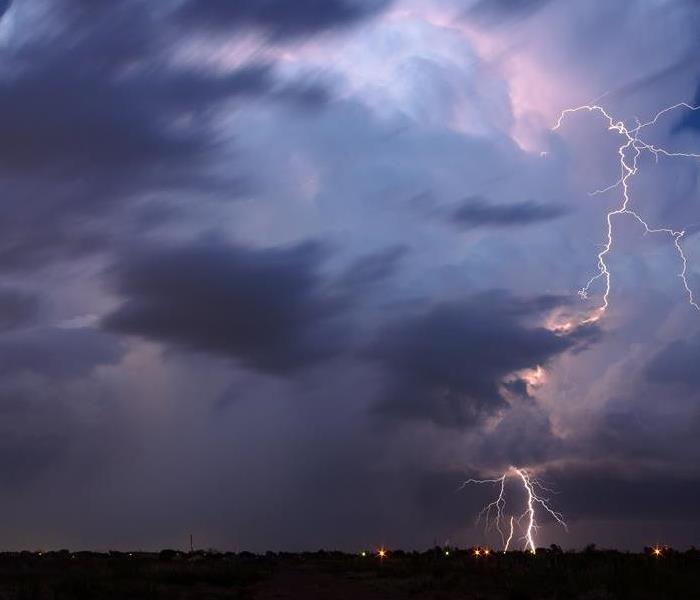 Storms can leave behind foundation problems.
Storms can leave behind foundation problems.
Storms can bring significant damage to various parts of your home, including the foundation. While the focus is often on visible damage such as roof leaks and fallen trees, it's crucial to recognize the potential impact on your home's foundation. Understanding how storm damage can affect your foundation is essential for early detection and necessary repairs. In this blog post, we will explore the risks associated with storm damage and its effects on your home's foundation.
Soil Saturation
Heavy rainfall during storms can saturate the soil surrounding your foundation. When the soil becomes overly saturated, it expands and exerts pressure on the foundation walls. This pressure, known as hydrostatic pressure, can lead to cracks, bowing, or leaning walls. It's important to address any signs of foundation movement promptly to prevent further structural damage to your home.
Intense storms can cause erosion and soil shifting around your foundation. As rainwater rushes and flows, it can wash away soil from around the foundation, creating voids or gaps. These empty spaces weaken the foundation's support, potentially leading to settlement and uneven settling of your home. The shifting soil can also cause foundation cracks and compromises its stability.
Foundation Heaving
In regions where freezing temperatures occur during storms, foundation heaving can become a concern. When moisture in the soil freezes and expands, it exerts upward pressure on the foundation. This pressure can cause the foundation to rise or heave unevenly, leading to cracks and structural instability.
Storms can result in water infiltration into your home through foundation cracks, basement windows, or compromised waterproofing systems. If left unchecked, this water intrusion can cause extensive damage, including moisture-related issues such as mold growth, rot, and deterioration of building materials. Regularly inspecting your foundation for cracks and addressing any waterproofing concerns can help protect your home from water damage.
Compromised Drainage Systems
Storms can overwhelm your home's exterior drainage systems, such as gutters, downspouts, and perimeter drains. Improper drainage or clogged systems can lead to water pooling near the foundation. The prolonged presence of water can weaken the soil and contribute to foundation problems over time. Maintaining and ensuring the proper functioning of your drainage systems is essential to mitigate potential risks.
Tree Damage
Trees near your home can present a significant risk during storms. Strong winds can cause trees or large branches to fall onto your home, damaging the foundation and other structural components. Tree roots can also extend beneath your foundation, potentially causing damage and destabilizing the structure. Regular tree maintenance, including trimming and removal of hazardous trees, can help reduce the risk of foundation damage.
Understanding the potential impact of storm damage on your home's foundation is crucial for protecting your property's structural integrity. From soil saturation and erosion to foundation heaving and water infiltration, storms can pose various risks. Regular inspections, prompt repairs, and proactive maintenance are key to identifying and addressing foundation issues early on. By taking the necessary precautions and seeking professional assistance when needed, you can protect your home's foundation and ensure its long-term stability.
Understanding the Accuracy of Mold Home Testing Kits
5/30/2023 (Permalink)
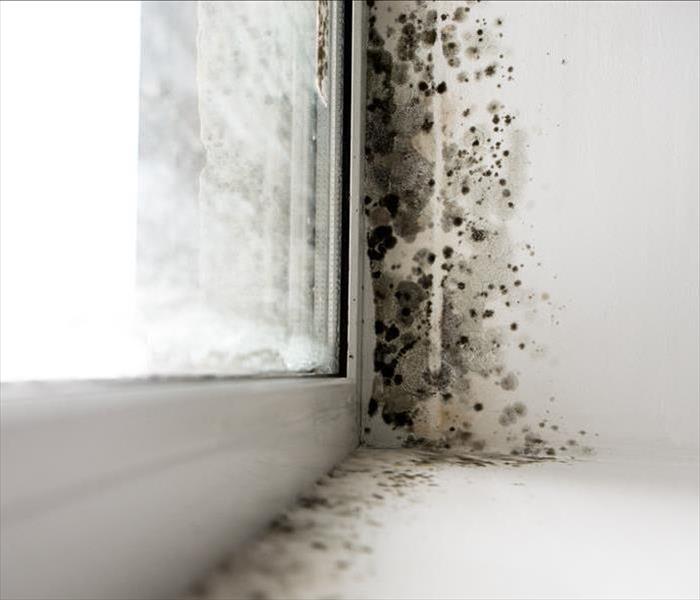 The accuracy of mold home testing kits can vary widely.
The accuracy of mold home testing kits can vary widely.
The accuracy of mold home testing kits can vary widely depending on several factors, including the quality of the kit, the type of sample collected, and the interpretation of the results. Here are some important things to keep in mind when using a mold home testing kit.
Mold is everywhere
It's important to understand that mold is present in the air and on surfaces everywhere, and some mold spores are always present indoors. Therefore, even if a mold test comes back positive, it doesn't necessarily mean that there is a significant mold problem in your home.
Different kits have different levels of accuracy
Mold home testing kits can vary widely in their accuracy and reliability. Some kits may provide more detailed and accurate results than others. Before purchasing a kit, it's important to research the brand and read reviews to determine its reliability.
Sampling technique
The way you collect the sample can also impact the accuracy of the results. For example, if you don't collect the sample correctly, you may not get an accurate reading of the mold levels in your home.
Interpreting the results
It's important to interpret the results of a mold home testing kit carefully. Some kits may provide a visual indicator that can be difficult to interpret, while others may require you to send the sample to a lab for analysis. It's important to understand what the results mean and what actions you should take based on the results.
Professional mold testing
If you're concerned about mold in your home, it's often best to hire a professional mold testing company to perform an inspection. Professional mold testing companies can provide a more accurate and comprehensive assessment of mold levels in your home and recommend appropriate remediation measures.
Mold home testing kits can be a useful tool for homeowners to monitor the presence of mold in their homes. However, it's important to understand their limitations and potential drawbacks, including their accuracy and reliability. If you're concerned about mold in your home, it's often best to consult with a professional mold testing company to get a more accurate and comprehensive assessment of your home's mold levels.
5 Key Factors to Consider When Choosing a Fire Restoration Company
4/10/2023 (Permalink)
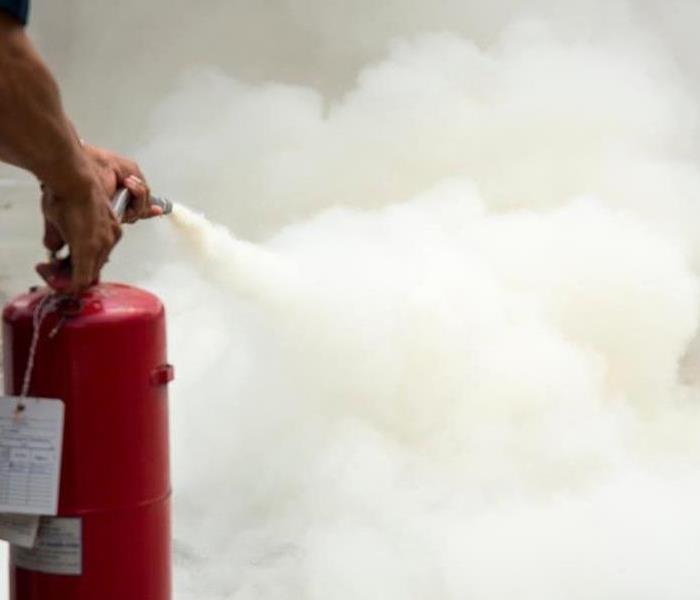 dealing with fire damage can be stressful, give SERVPRO a call today.
dealing with fire damage can be stressful, give SERVPRO a call today.
Dealing with the aftermath of a fire in your home or business can be overwhelming and stressful. The process of fire restoration requires the expertise of professionals who have the knowledge, experience, and tools to restore your property to its preloss condition. But with so many fire restoration companies out there, it can be challenging to know which one to choose. In this blog, we'll discuss what you should look for in a fire restoration company.
Experience and Expertise
The first thing you should look for in a fire restoration company is experience and expertise. You want to work with a company that has a proven track record of successfully restoring properties after a fire. Look for a company that has been in business for several years and has experience working with properties of all sizes and types. Additionally, the company should have trained and certified professionals who have the knowledge and skills to handle all aspects of fire restoration.
Response Time
When a fire occurs, time is of the essence. The longer you wait to start the restoration process, the more damage your property may sustain. That's why it's essential to choose a fire restoration company that can respond quickly to your call. The company should have 24/7 availability to ensure that they can start the restoration process as soon as possible.
Insurance and Licensing
It's also essential to work with a fire restoration company that has the proper insurance and licensing. The company should be fully licensed and insured to provide fire restoration services in your area. Additionally, they should have liability and worker's compensation insurance to protect you and their employees in case of any accidents or damages that may occur during the restoration process.
Range of Services
Fire damage can be extensive and may require a range of restoration services. Look for a fire restoration company that offers a comprehensive range of services, including smoke and soot removal, structural repairs, content cleaning, and odor removal. Having a company that can handle all aspects of the restoration process can make the process smoother and more efficient.
References and Reviews
Before choosing a fire restoration company, it's essential to do your research. Look for references and reviews from previous clients to get an idea of the company's reputation and the quality of their services. You can check the company's website or review sites such as Yelp or Google to read reviews from previous clients. Additionally, you can ask the company to provide references and speak to previous clients directly.
Dealing with fire damage can be stressful, but choosing the right fire restoration company can make the process smoother and less overwhelming. When choosing a fire restoration company, look for experience and expertise, quick response time, proper insurance and licensing, a comprehensive range of services, and positive references and reviews. By choosing the right fire restoration company, you can rest assured that your property is in good hands and that the restoration process will be handled efficiently and effectively.
Water Damage. A Step-by-Step guide to follow
3/27/2023 (Permalink)
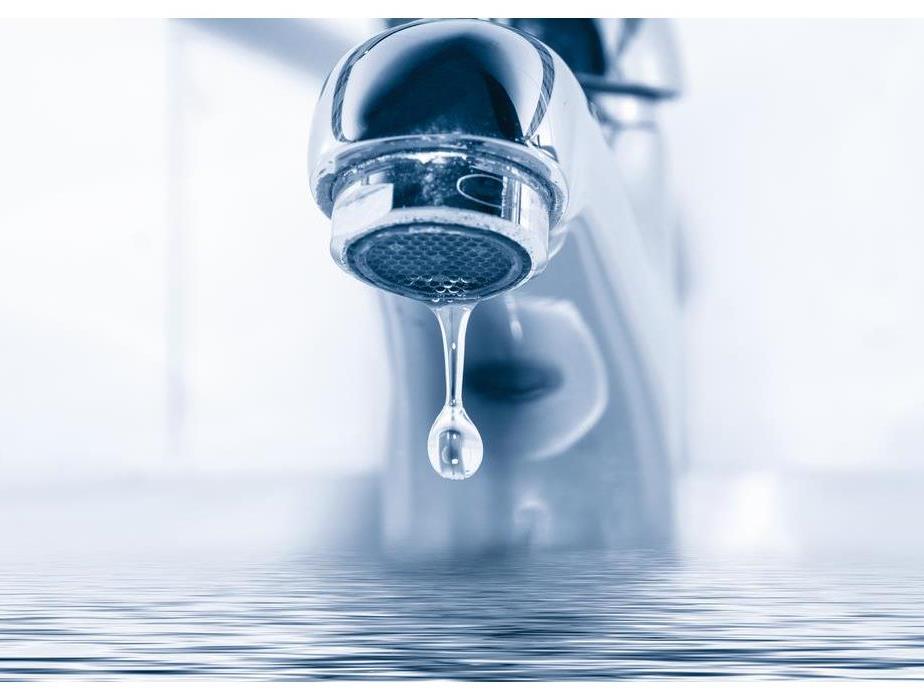 Prevent water damage in your home, give SERVPRO a call at the first sign of a water loss.
Prevent water damage in your home, give SERVPRO a call at the first sign of a water loss.
If you are concerned about water damage in your home, it's important to know what causes it and how to prevent it. Your risk of experiencing a water loss is much higher than most homeowners realize. This is especially true if you live in an area that gets hot or cold weather, or experiences fluctuations in temperature all year long. Some common causes of water damage include broken pipes and toilets, leaking roof tiles or gutters, and faulty appliances such as dishwashers, washing machines, ice makers and more. A proactive approach is the best way to prevent water damage in your home.
Water damage prevention begins with a proactive approach
Water damage is a very common problem in homes. Water damage can be caused by many different things including leaks, water pressure problems, overflowing toilets, and leaking pipes including water heaters.
Assess your homes water risk.
A water risk assessment is a process of identifying the risks in your home that could lead to water damage. This is generally done by professionals, but it can also be done DIY. A professional can help you identify and fix problems before they cause damage, while a DIY kit will give you some basic information on how to assess the risk of water loss in your home.
A professional will conduct an inspection of various areas around your house including roofing materials, gutters and downspouts, and attic vents.
If any issues are found during this inspection, they will be addressed by either replacing or repairing damaged parts so that they don't lead to future problems like mold growth due to moisture buildup inside walls/ceilings etc.
Monitor water usage and report any leaks.
It's important to know how much water you use in a day, week, month and year so that if you do have a leak or other problem with your system it can be addressed quickly and effectively. To test whether there are any issues with the plumbing in your home:
Check for drips from faucets and showers. If you notice any drips at all during these tests then there's probably an issue with either the fixture itself or its connections with piping under floors or behind walls. Give a professional plumber a call at the first sign of water damage.
Check Toilets
Toilets can be a source of major water damage. If you hear a toilet running, check for leaks by looking under the rim of each bowl as well as underneath where you would normally find the water damage. If there is any leakage, fix it immediately before secondary damages occur. Check the guts of the toilet to ensure there are no future leaks.
Plumbing Fixtures
The first thing you should do is check for leaks in your existing fixture. If there aren't any visible signs of water loss and no one has reported noticing any drips coming from their bathroom ceiling or floors then it's likely that your current fixture isn't causing any problems at all.
If you do find evidence of leakage around the base of your valve assembly, then its possible it is time to replace.
There are many things you can do to prevent water loss in your home. Don't let it be a problem in your home. Take action and pay attention when things don't seem right to help prevent water damage that can potentially be costly. Give SERVPRO a call if your in need of water restoration services, we are available 24/7.
Water mitigation vs. Water Damage Restoration
3/7/2023 (Permalink)
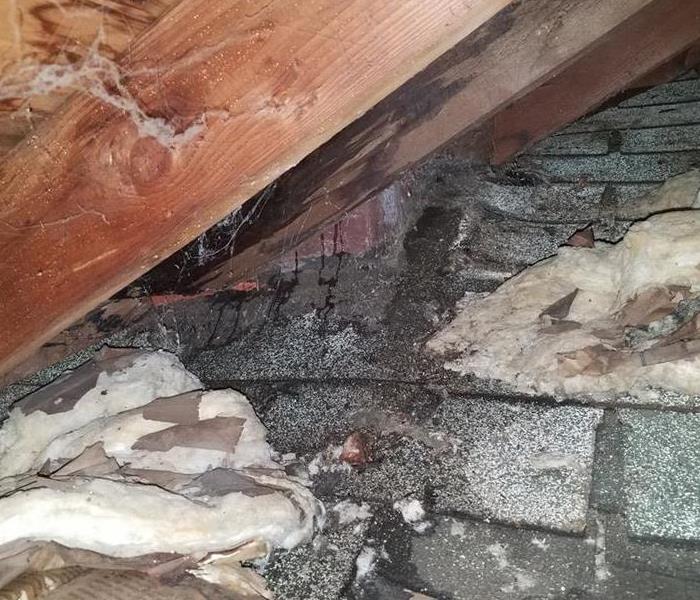 When your in need of water damage restoration, SERVPRO is here to help!
When your in need of water damage restoration, SERVPRO is here to help!
Water damage can cause major issues in your home, but it’s not always easy to determine how you should proceed. Most people assume they need water mitigation services, but what if they are actually experiencing water damage? How do you know which one is right for you? The difference comes down to timing and the extent of the damage.
Experienced Water Damage?
If you have experienced water damage, you may be feeling overwhelmed. It can be difficult to know where to start and what your options are. You might not know who to call or what the process is for getting things back on track after a leaky pipe or burst pipe has wreaked havoc on your home.
In this guide, we'll discuss what causes water damage and how it affects your property so that you can better understand the situation at hand and make more informed decisions about how to move forward. We'll also go over some tips for mitigating water damage in the future so that you don't have to deal with this issue again!
How to proceed?
When dealing with water damage, there are many factors to consider. It is important to know what you are dealing with and how much time you have. This will help determine your options. Additionally, it is important to understand the extent of the damage and whether or not it can be repaired or must be replaced.
It is crucial for homeowners who experience any kind of flooding, whether due to storm surges, high tides after heavy rains fall on coastal areas to contact a restoration company immediately at the first sign of water loss.
Water Mitigation or Water Damage Restoration
If you’re wondering whether you need water mitigation or water damage restoration, the answer is both. The best way to protect your home and belongings is through a proactive approach that includes both water mitigation and water damage restoration.
Water mitigation involves taking steps to prevent damage from happening in the first place. Water mitigation can include sealing off areas where leaks might occur, installing sump pumps, or using flood alarms to sound an alarm when it detects moisture buildup in certain areas of your home. Water damage restoration is a reactive measure which means that it takes place after the initial source of moisture has been removed. In this process, technicians clean and dry out your home so that any remaining moisture does not cause further damage
How do I know which one to Choose?
When it comes to water damage restoration vs. mitigation, there are some key differences. Both processes will help you get your home back to livable condition, but only one of them is a permanent solution. Your choice depends primarily on the type of damage present and how quickly you need to get things back in order.
Water mitigation is a temporary solution used to remove any standing or pooled water from your home so that it doesn't continue causing issues like mold growth or structural damage over time. This process typically uses air movers and dehumidifiers that dry out rooms with fans pushing air through them at high speeds while also extracting moisture using powerful vacuums designed specifically for this purpose
Water Damage Restoration is done AFTER Water Mitigation has removed all possible sources of standing water from your property after flooding events have already occurred.
The most important thing to remember is that this isn’t an either/or decision. You can work with a company that offers both water mitigation and water damage restoration services. It is often best if you do so because they have the expertise and resources needed to help you recover from any type of flood damage—whether it’s minor or major.
Top Safety Tips to Avoid Cooking Fires
12/5/2022 (Permalink)
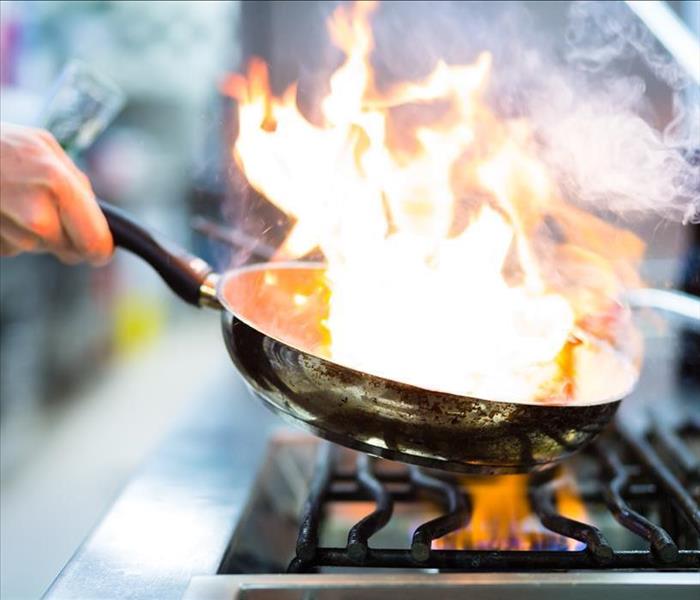 Cooking fires are the leading cause of home fires.
Cooking fires are the leading cause of home fires.
Tips To Keep Yourself Safe While Cooking
Cooking is one of the great joys in life. But, it can also be dangerous if you’re not careful. Whether you’re using a stovetop, an oven/microwave oven/toaster oven/air fryer/instant pot etc. or even just keeping food warm on the stovetop, here are some tips to keep yourself safe while cooking:
1. Watch your cooking.
When you are cooking, don’t leave the kitchen. If you must leave, turn off the stove and unplug it from its power source. Don't cook when you're tired or have had alcohol (or drugs) before starting to prepare food. Don't leave small children alone in the kitchen while you're preparing food.
2. Keep things that can burn away from your stovetop.
The second tip is to keep things that can burn away from your stovetop. Keep pots, pans, towels, paper towels, prepared or raw food (that isn’t currently cooking), and kids away from the stovetop.
3. Clean up cooking messes right away.
You should always clean up cooking messes right away. If left on the stove, grease fires can be hard to extinguish and are very dangerous. You should also have a fire extinguisher in your kitchen and a smoke alarm that is in good working order.
4. Be alert!
You wouldn't drive a car if you were sleepy, drunk, or distracted, so why cook? It's important to be alert when using your stove. If you're feeling tired, it might be best to wait until later in the day when you are more awake and alert.
It's also a good idea to avoid cooking when you have consumed alcohol because it can affect your judgment and ability to operate safely while cooking.
5. Stay in the kitchen when you are frying, grilling, or broiling food.
The kitchen is the place where you should be when frying, grilling or broiling food. If you leave the kitchen for a minute to check on your kids or answer a phone call, turn off the stove before you go. Leaving an open flame unattended is very dangerous and could lead to fires or even explosions.
6. If you have young children, use the stove’s back burners whenever possible.
If you have small children, it’s important to keep them as safe as possible. One way to do this is to use the back burners whenever possible. They are farther away from the edge of the stove and therefore safer than front burners.
Stove burners are generally easier for young children to reach because they are closer to their height. However, front-facing burners have a higher risk of tipping over when touched or bumped by a child. This can lead to spills and fires if not cleaned up quickly enough. If you must use front-facing burners for cooking purposes, be sure that your child has been properly supervised at all times while cooking with them in order to avoid potential accidents.
7. Keep pot handles turned inward on the stovetop.
Using pot handles that are turned inward on the stovetop is another way to prevent spills and avoid burns. If you drop a pot, it has a better chance of not spilling if the handle faces inwards, rather than outwards. Make sure that your cookware doesn't have sharp edges or points, which can cause injury if someone bumps into them.
To avoid potential fire hazards with your cooking utensils, make sure all items are stored neatly in designated spots (not scattered across countertops) and that they have no cracks or chips in their surfaces that could allow grease or other liquids to leak out onto hot surfaces:
8. Keep knives and other sharp objects out of the reach of children.
If you have small children in your home, it's important to keep knives out of their sight and reach. Try placing them in a drawer or on a high shelf where they can't be easily accessed without an adult's assistance. Similarly, never leave knives lying around on countertops or in sinks; if you're using one while cooking and need to put it down for some reason, place it back into its holder or put it away before doing anything else! Finally, never leave sharp objects such as screwdrivers and scissors unattended- even for just a second because someone could get hurt by accidentally bumping into them while performing another task (or trying to grab something from the sink).
9. Store matches and lighters out of reach of children – preferably in a locked cabinet.
One of the most common causes of fires in homes is the improper use of lighters and matches. The best way to reduce this risk is to store them out of reach, preferably in a locked cabinet. Keep in mind that some lighter fluid may be toxic if ingested, so keep it stored away from children even if you have an unopened bottle.
10. Always keep an oven mitt and lid nearby when you’re cooking anything.
If you see smoke coming out of your kitchen, immediately turn off all sources of heat (stovetop burners, electric burners). If there are flames, do not attempt to put out a grease fire with water! Instead, use baking soda or flour to smother the flames. Then call 911.
Cooking is a fun and rewarding pastime, but it can also be dangerous if you’re not careful. Cooking fires are the leading cause of home fires and injuries in the United States according to the National Fire Protection Association (NFPA). In fact, cooking-related fires result in an estimated 2,500 deaths and 12,500 injuries each year. So what can we do to avoid these types of accidents? The best way is to follow our ten tips above – they include simple things like keeping your stovetop clean and making sure that you always have an oven mitt handy when working around hot oil or other flammable liquids. Plus there are a few more tips like always keeping young children away from knives!
If your East Naples, FL home experiences a fire from cooking, SERVPRO of East Naples is here to help! Give us a call!
I Found a Leak Under My Kitchen Sink
11/5/2022 (Permalink)
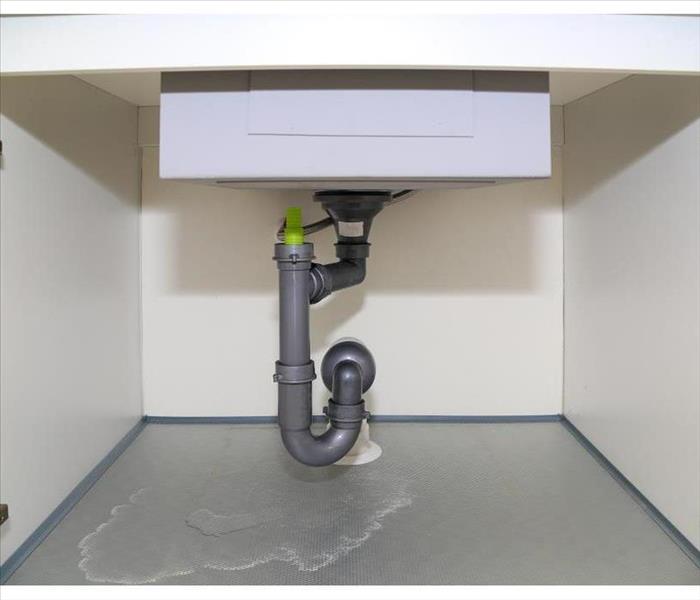 A leak under your kitchen sink can be a big problem.
A leak under your kitchen sink can be a big problem.
A Leak Under the Sink
Consider this scenario: “I found a leak under my kitchen sink. I was doing some organizing when I saw that there was water coming out from underneath the cabinet. After investigating, I realized it wasn't just water; it was oily liquid as well. There were no other signs of damage in the house, so this must be an isolated incident that's not going to spread anywhere else.”
Now that we know what happened and why, let's find out what you should do if you have a leak under your kitchen sink!
A Big Problem
A leak under your kitchen sink can be a big problem. The water will gradually destroy the wood and other materials around it, and if it's not stopped soon enough, it could become an expensive problem.
It's hard to find the leak. There are a lot of places where leaks can occur - around pipes or faucets, in hoses or tubes that connect between different parts of your home. You may have found this out already if you've already searched for the source by turning off all of the water in your house and trying to locate where it's coming from.
Stopping the leak takes time and effort while doing so properly requires skill or knowledge that many homeowners don't have readily available. If something goes wrong while fixing your sink then you could make matters worse rather than better as well as cause even more damage than before!
Tips When You Find a Leak
If you have a leak under your kitchen sink, here's what you should do:
- Shut off your main water supply
- Find the main shutoff valve under your sink and turn it clockwise to close it.
- Call your insurance company if you have homeowners insurance
Call Your Insurance Company
After you've shut off the water, call your insurance company if you have homeowners insurance. This is a great time to check on how much coverage you have and what's covered by it. It's also a good idea to ask about limitations, like whether there are any deductibles or co-pays that need to be paid before the claim can be processed.
Once they've confirmed their coverage and determined how much they'll pay out, they'll let you know what steps need to be taken next, such as getting estimates from contractors so that they can get reimbursed by the insurance company
Call the Professionals
SERVPRO of East Naples is the professional restoration company for you. We have the training and experience to fix your problem. We can handle any size job, from small to large. SERVPRO of East Naples is available 24 hours a day, 7 days a week, including all holidays. We work in both residential and commercial buildings, and work quickly to get you back to normal!
When you find a leak under your kitchen sink, turn off the water, call your insurance company if you have homeowners insurance, and then call SERVPRO of East Naples.
Fire Damage and Water Damage
10/13/2022 (Permalink)
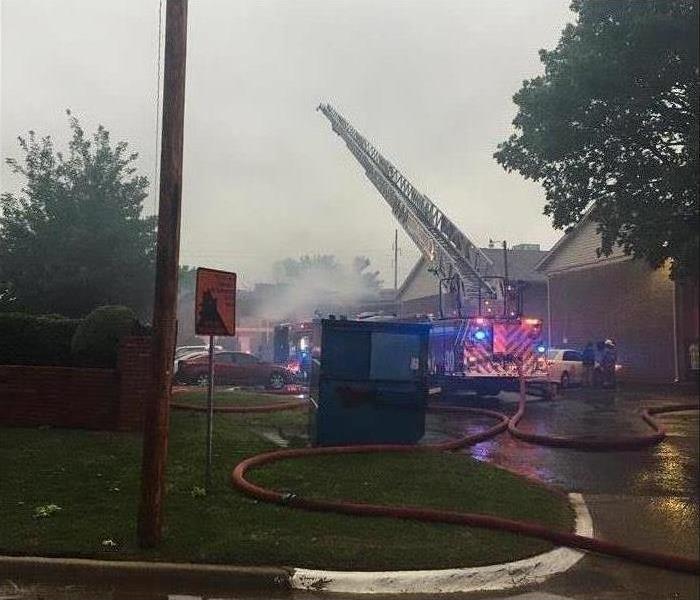 SERVPRO can quickly respond to any fire.
SERVPRO can quickly respond to any fire.
Fire and Water Damage Go Together
In the wake of a fire, your home or business may need both fire and water restoration services. These are two different types of damage that can occur during a fire. You should make sure that you know what fire and water damage are before calling a restoration company to help clean up after your fire.
Water Damage after a Fire
You may not think about it until it’s too late, but frequently fire in a home or business often leads to water damage in the building. Water damage after a fire is a serious problem. As you may have seen in the news, water and smoke can cause serious structural damage to buildings. Water also damages furniture, appliances, and other items in your home.
Water contains minerals that are harmful to building materials and electronics. This can lead to corrosion of metal components in your home as well as electrical damage due to corrosion of wires or circuit boards inside electronic devices like televisions, computers, and phones.
Mold spores need moisture to grow so if there is an excess amount of moisture present they will begin growing on any available surface within 24 hours of exposure - even if it's just dampness!
Fire and Water Restoration After a Fire
If you've experienced a fire, your home or business may need fire restoration and water restoration services. Fire damage is caused by flames, smoke, heat and soot that linger after the flames are extinguished. Water damage can occur when firefighting efforts involve heavy use of water to extinguish the blaze.
SERVPRO of East Naples provides 24-hour emergency service and is available 365 days a year to respond to your fire or water damage emergencies in your Naples, FL home or business. Our team of highly qualified technicians will respond immediately and work with you to develop an effective plan for restoring your property back to pre-disaster condition. We also provide mold remediation services as needed.
Damage from a fire hose can be extensive as firefighters often use large amounts of water during their response efforts in order to extinguish fires quickly and safely. There are several types of commercial buildings at risk for this type of damage including restaurants, grocery stores, and banks because they often contain large quantities of flammable materials. These items (like food products or electronics) can ignite easily if exposed directly to too much heat. This helps the fire spread rapidly through these types of buildings.
A fire can cause a lot of damage. If you’re experiencing water damage after a fire, it’s important to know what to do next. The first step should be to call the professionals at SERVPRO of East Naples. We will be there quickly to help restore your home or business after both fire and water damage.
How SERVPRO Makes Damage Insurance Claims Easier
8/31/2022 (Permalink)
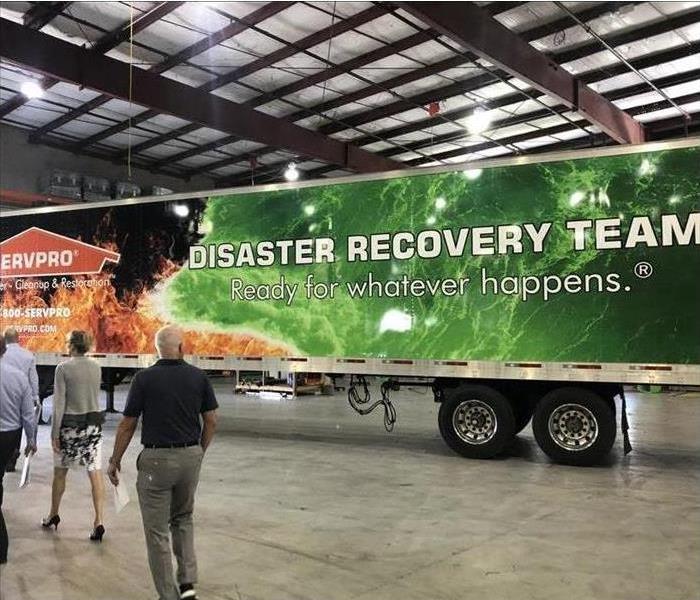 Disaster Relief Team
Disaster Relief Team
How SERVPRO Makes Damage Insurance Claims Easier
When a commercial property is damaged by a storm, plumbing issues, fire or another unfortunate event, the first priority is to get it fixed. Filing an insurance claim and getting subsequent repairs for any damage can seem like a daunting process, but the fire and water damage restoration professionals at SERVPRO can make it simple for any client. Here are some of the claim services and benefits offered for customers.
Fast Emergency Response to Any Disaster
No matter the issue facing a commercial property, SERVPRO's team of restoration experts is ready to tackle the project as soon as they are contacted. This quick response ensures the claim and restoration effort will be addressed and ultimately finished in a timely manner. Count on these crews to provide trusted service for any of the following issues:
Water damage
Fire damage
Mold remediation
Contents drying
Odor removal
Crews are available for 24/7 service and are certified in their field by the industry-leading Institute of Inspection, Cleaning and Restoration Certification.
Use of Electronic Claim Services
There is easy access to any recorded information regarding the claim with SERVPRO's electronic filing system. This service guarantees accurate online information that makes it simple to stay on top of the damage restoration process.
Tracking Claims With an Inventory System
Dealing with insurance claims is made much easier thanks to SERVPRO's inventory system. This service tracks all the losses within a East Naples, FL, building and includes pictures of any important, damaged items. This inventory system lays out all the necessary damage information for clients to easily refer to at any point during the cleanup and restoration process.
Customers working with SERVPRO's restoration experts benefit greatly from their fast response to any building disaster, electronic claim services and helpful inventory system, making for a seamless rebuild of any commercial property.
Call the Professionals for Category 3 Water Damage
8/26/2022 (Permalink)
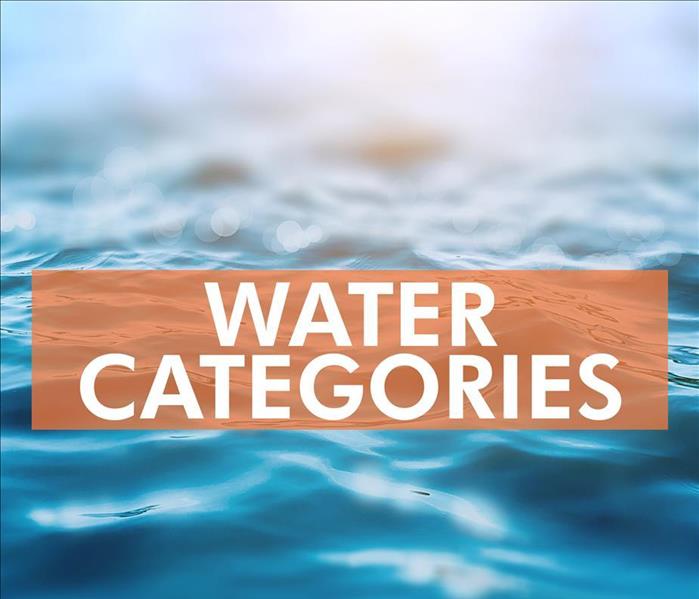 Water damage categories
Water damage categories
Any water damage your Village Walk, FL, property sustains needs to be handled quickly to avoid future issues. When the damage is caused by flood water, it isn’t normal water that is being dealt with. Before diving in to clean up the mess, it’s important to understand the different categories of water loss.
Water Damage Categories
The IICRC classifies water damage in the following three ways:
Category 1: Considered clean water, this is the least severe and may usually be cleaned up without any concerns if there is a minimal amount of damage. This category is often caused by a broken pipe or overflowing sink.
Category 2: Known as grey water, it may have chemicals or bacteria in it. While not necessarily harmful, it still requires an extra level of detail during cleanup. Grey water comes from a urine-only toilet overflow or leaking appliances.
Category 3: If your water problem was caused by flooding, you likely have black water damage. This type has many contaminants from sewage and debris that require added levels of safety. When dealing with this type of water loss, it’s best to call water and mold damaged restoration
Flood Water Cleanup
Unlike clean water, black water must be handled with care. Prior to coming into contact with it, personal protective equipment is recommended. When using a certified company to handle the mess, its trained technicians will be suited up with the right gear and have specialized equipment to contain the area, extract the water and clean affected areas. They will be trained to prevent cross-contamination, as well as find hidden issues, such as mold growth. The team will also properly dispose of waste and unsalvageable items.
While no unwanted water in your property is good, flood water is considered black water and requires extra safety precautions to ensure it is handled right.
What To Do Right After a Storm Damages Your Home
8/10/2022 (Permalink)
 Storm damaged a home in Quail Creek, FL.
Storm damaged a home in Quail Creek, FL.
What to Do After Your House Is Damaged by a Storm
You hear the wind blowing and the rain pounding on your window panes, and you hope your home in Quail Creek, FL, will remain untouched by the storm. Unfortunately, this is not the case. A tree falls on your roof, and water pours into your home, soaking your carpets and covering your hardwood floors. Here's how to stem the tide of storm damage in the event's immediate aftermath.
1. Document Damage Before Attempting Immediate Repairs
If you are planning to submit a claim to your insurance company for the damages, you will want to record them prior to attempting any immediate repairs. Make a list of damaged items, and take photos or video of each.
2. Make Immediate Repairs Only To Prevent Further Damage to Your Home
Take the following steps when attempting immediate repairs or cleanup:
- Cover leaking roofs with a tarp to prevent more rainfall from entering the home.
- Pull up wet carpet to prevent mold and move it to a dry location.
- Throw away all perishable food that has spoiled.
Make sure all articles being removed from the home were documented on the inventory list of damaged items.
3. Exercise Caution If You're Staying in a Damaged Home
To restore lost electricity in your home, use generators outside, away from windows and doors. Make sure your sewer system is working before flushing toilets, using water stored previously for this function if necessary. Open windows and run fans inside your home to circulate air and aid the drying process.
You may also choose to contact a company that can perform emergency restoration services in your home. If so, keep receipts for services provided, as well as for any purchases made for immediate repairs, such as a tarp for the leaking roof.
Hopefully, your home will never be subjected to storm damage. If it is, however, these storm tips can get you started on the road to recovery and get your life back to normal as quickly as possible.
3 Preventative Plumbing Maintenance Tips for Business Owners
7/27/2022 (Permalink)
 Schedule a plumbing inspection before they grow into even more significant problems
Schedule a plumbing inspection before they grow into even more significant problems
Preventative Plumbing Maintenance Tips
As a business owner in Olde Cypress, FL, you know that plumbing issues can cause many headaches. They are inconvenient, and the damage can be severe enough to require water damage restoration services. Fortunately, you can take preventative measures to avoid plumbing problems altogether.
1. Find a Good Plumber Before Issues Arise
Do you wait to call a plumber until you face an issue such as a broken pipe or a clogged water main that leads to flooding? In an emergency, time is of the essence. Waiting to call professionals until an emergency needs immediate attention doesn't give you time to find a plumber who you know will do a good job.
Before problems arise, do some research by reading online reviews and asking other business owners for referrals. Hiring commercial plumbers and seeing how they work can give you an idea of whether or not they're someone you can rely on. Taking the time to do your due diligence ensures that you'll find a reliable plumber you can trust when problems arise.
2. Avoid Plumbing Problems by Scheduling Maintenance Appointments
Just like getting regular checkups with your doctor is good for your physical health, scheduling routine maintenance appointments with your plumber can detect plumbing issues before they grow into even more significant problems that are costly to resolve.
How often you should maintain your plumbing system depends on the number of people visiting your business daily. A building with hundreds of visitors per day will require more frequent upkeep than a small office. Consult with your plumber to determine how often you should schedule maintenance appointments.
3. Pay Attention to Small Plumbing Issues
Doing your own checks for plumbing problems can go a long way toward preventing issues from escalating. A leaky faucet can indicate damaged or eroded fixtures or issues with water pressure. Slow drains can signify clogs, and fluctuating hot water temperatures (too hot or not hot enough) can indicate problems with your water heater.
By following these preventative measures, you can avoid plumbing issues and keep your business in Olde Cypress, FL, running smoothly.
Post-Flood Tips
7/19/2022 (Permalink)
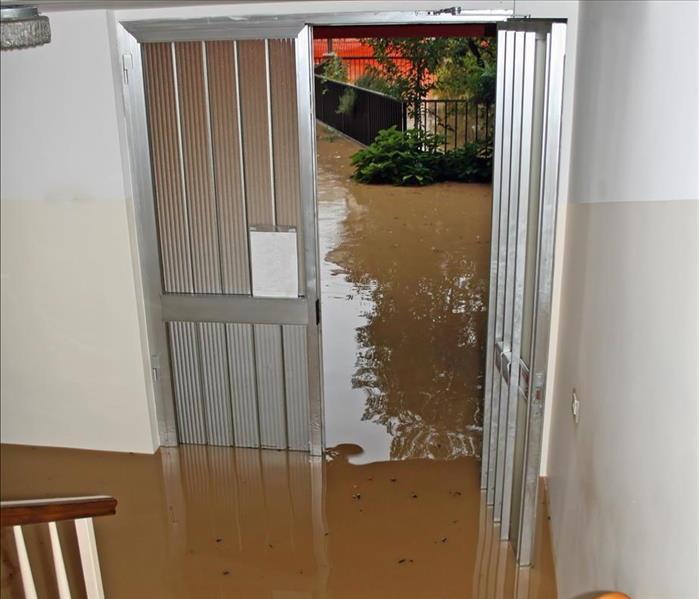 Flood damage in a home in Island Walk, FL.
Flood damage in a home in Island Walk, FL.
Steps To Take After a Storm
Are you stuck with a home that is completely engulfed in flood water? There are certain actions that are necessary to take in order for you to protect your property. Here are three important steps you need to take after the storm to protect your best interests.
1. Tell your mortgage lender immediately. Not only will you most likely be able to waive any late fees on your bill - you may even be able to defer payments if your area has suffered from an extreme weather-related tragedy. That is why it is important to take this step before any other.
2. Call your homeowner’s insurance company. The earlier you file a claim, the more likely it is that you will have it quickly approved. Just be prepared to record any water damage and related repairs for their records as well as your own. An insurance adjuster may need to inspect the property, as well, so be prepared for his or her arrival.
3. Find a trusted, professional cleanup company. It is never safe or very effective to clean and repair your home yourself after the flood water has left its effects, so you need to find the best local Island Walk, FL, residential storm damage service to help you create a thorough cleanup plan that gives you the best chance of restoring your property.
Above all else, make sure that you keep yourself and your family safe after a storm. A flooded home can cause contaminated standing water, electrical dangers and other hazards that you need to be aware of. In some cases, it is best to avoid your property at all costs until local authorities give the all-clear. Once everything has settled down at and around your house, a professional cleanup team can help you figure out how to deal with flood water and its related damage so you and your loved ones can be safe and happy in your home once more.
3 Steps To Repair a Roof After Storm Damage
7/11/2022 (Permalink)
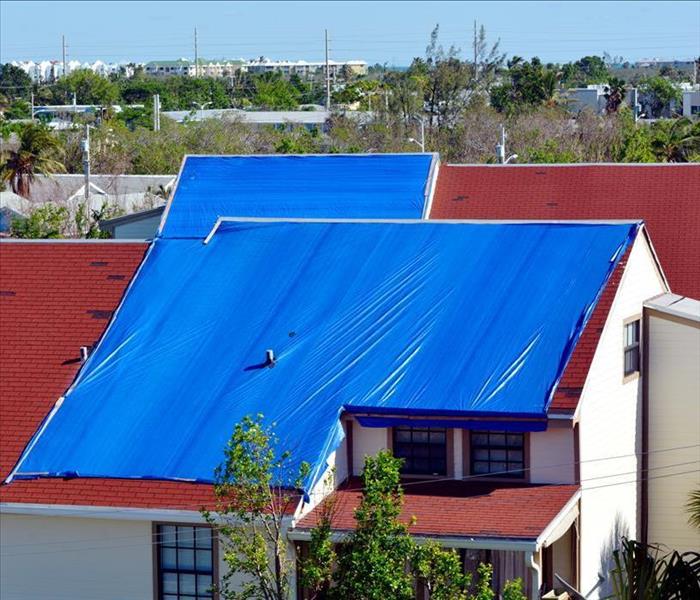 Tarping your roof will help you prevent the roof from deteriorating.
Tarping your roof will help you prevent the roof from deteriorating.
What Happens During Roof Repair?
When storms in Vineyards, FL, damage your home’s roof, the idea of a roof repair can seem overwhelming. However, understanding what repairing a roof entails may make you feel more at ease about the process.
1. Assessment
Storms can affect various parts of a roof, and in order to know how to proceed in the repair process, it’s often necessary to assess the damaged roof. Hail and wind damage can cause shingles to crack or even blow away entirely, and the extent of the damage will determine what will happen next. In order to receive a thorough and accurate assessment, it can sometimes be helpful to employ storm damage restoration professionals.
2. Mitigation
Part of the roof repair process generally includes mitigating the damage. After an assessment has identified roof damage, tarps and board-up methods are often used to prevent the roof from further deteriorating. In addition to preventing the exterior of the home from sustaining more damage, it can also be useful to take measurements to protect the interior of the home. Roofs that have been affected by storms may cause water to become trapped in the home’s ceilings. Removing water from the ceiling in a timely manner can help to minimize the damage to the interior of the home.
3. Restoration
After an assessment and mitigation, the roof is restored. Any debris that is on or around the roof is first removed. Then, individual shingles that have been cracked or that have blown away due to strong winds can be replaced. If widespread damage has occurred to your roof, however, it may be necessary to replace the roof entirely to ensure the home is properly protected.
Knowing what is involved with a roof repair can help make the repair and restoration process less stressful. The repair process often involves the assessment of the roof, mitigating the damage and restoration.
3 Tips To Save Wood Floors From Water Damage
6/30/2022 (Permalink)
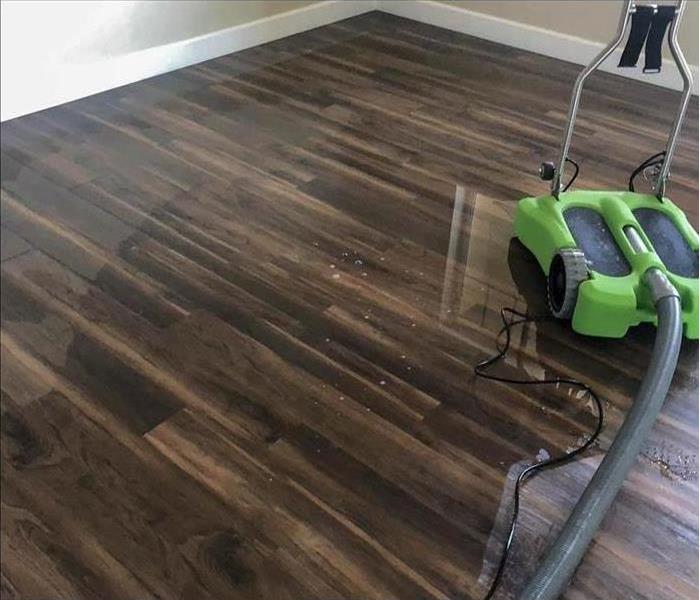 Standing water on hardwood floor
Standing water on hardwood floor
Three Ways to Prevent Water Damage to Wood Floors
Wood flooring can be susceptible to water damage whether it be a minor spill of liquid or a serious pipe burst. In a commercial business space with wooden floors, it's vital to protect them from potential water damage. The following tips can help keep floors in good condition.
1. Dry Any Wet Floor Immediately
Once water makes contact with a wood floor, it is only a matter of time before the material faces damage. Be sure to remove the water and dry the area as soon as possible to minimize damage. This effort will vary depending on the amount of water to clean up and the amount of flooring area that needs to dry.
2. Determine Water Source
Water damage has three distinct categories depending on the level of contaminants present. Clean water is contaminant-free and may come from a sink or hose. Gray water is contaminated with chemicals or biological hazards, possibly coming from a pipe burst or a faulty sump pump. Storm and groundwater flooding are sources of black water, the most serious and unsanitary type of water. Identifying the source of the water will determine which category of damage is at play and how to proceed.
3. Issue Necessary Repairs
Repairs may be necessary after water damage occurs. This can include plumbing repairs that caused the water damage, such as a pipe burst, or structural repairs to the flooring. Your wood floors may exhibit visible damage such as stains, buckling or crowning of the boards. Depending on the extent of damage, the flooring may need to be replaced. A water damage restoration company servicing Island Walk, FL, can help to repair the property after experiencing any type of flooding.
Keeping wood floors safe and pristine from water damage requires swift action to dry the area, determine the water source and carry out the necessary repairs at the property.
How To Mitigate Roof Damage After a Storm
6/12/2022 (Permalink)
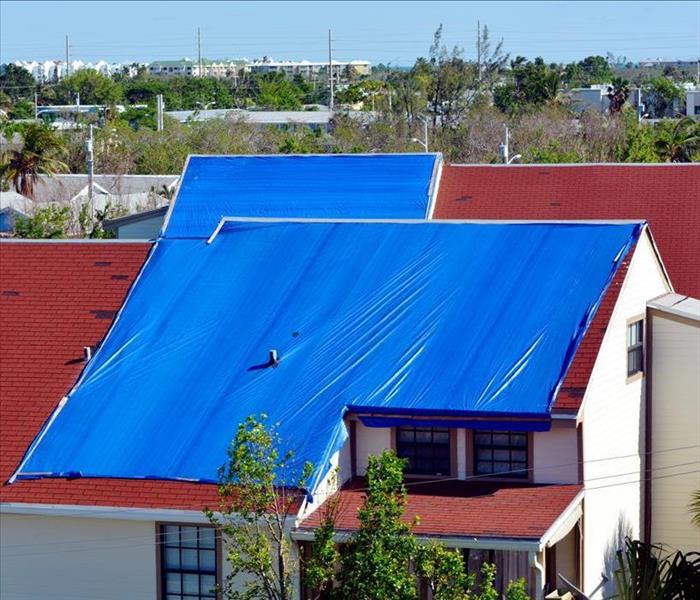 Apply a tarp over your roof after storm damage.
Apply a tarp over your roof after storm damage.
How to Prevent Roof Damage Following a Storm
After a severe storm causes roof damage to your home in Golden Gate, FL, you may need to file a claim with your insurance provider to help pay for repairs. However, your insurer will expect you to take various measures to mitigate your losses before approving your claim.
Apply a Tarp Over Storm Damage
Tarping your roof will prevent water from leaking into your home after hail, snow, rain, or wind lead to:
- Cracks, holes, and detachment of shingles
- Granule layer loss and consequently premature roof decay
- Soffit damage from moisture rotting underlying wood
- Fascia boards damage that compromises your roof's drainage system
An emergency storm repair service can secure a tarp or board up areas where water could enter your home to cause further damage.
Cover Skylights and Their Surrounding Roof Supports
Severe storms can impact your home's skylights. For example, strong winds and hail can crack the glass or compromise the roof flashing around them. You can address hail and wind damage by covering broken skylights with plywood boards or vinyl sheets from a hardware store. Nonporous plastic bags are also helpful if you cannot access other materials.
Inspect Gutters To Avoid Roof Damage
Severe wind can force your home's gutters out of alignment and prevent them from directing water flow away from your roof. In addition, ice blocking the gutters can lead to inadequate roof drainage. As a result, water can freeze in cracks and spaces between roof shingles, causing them to expand and contract as it melts and exacerbating the damage.
Strong winds can also deposit debris in your gutters so they bend and detach under the excessive weight, rendering them ineffective for directing water off your roof. It is essential to contact your insurer as soon as possible for instructions about initiating gutter repair and replacement to mitigate the damage.
A severe storm in Golden Gate, FL, can wreak havoc on your home, but addressing roof damage as soon as possible can help you avoid additional damage and costly repairs.
3 Steps for Dealing With Mold in Your Commercial Building
6/5/2022 (Permalink)
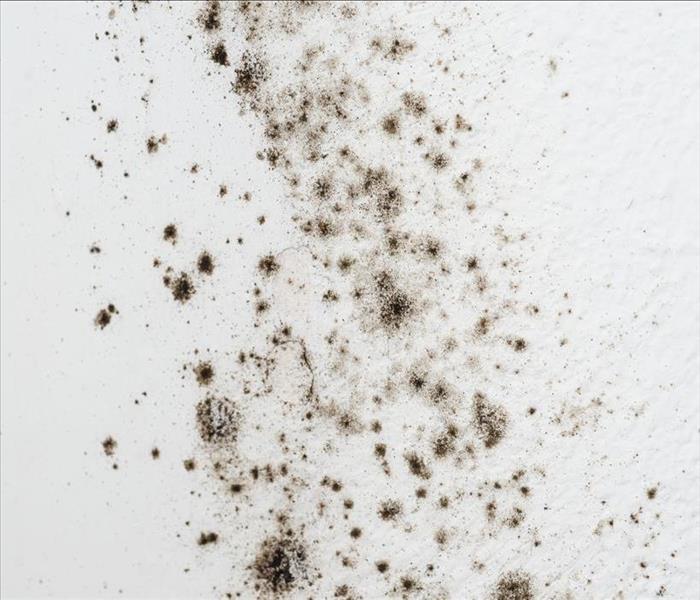 Does your building in East Naples, FL have a mold problem?
Does your building in East Naples, FL have a mold problem?
Mold In Your Commercial Building
Does your building in East Naples, FL, have a mold problem? Have you noticed black mold growing anywhere in your building? The cleanup process for this can feel overwhelming, but there are steps to take to make it simpler and easier.
1. Test
The first step when seeing any discoloration on walls or other materials is to determine if the contaminant really is mold or not. Most home improvement stores sell mold tests designed for consumer use. This gives you a good idea of what you're dealing with, and it can identify all sorts of molds, including black mold. If you have multiple floors, it's best to put a test on each floor. Additionally, be sure to also test your basement or ground levels thoroughly. If you have a big basement, it might be necessary to conduct multiple tests around the space.
2. Call
If the tests come back positive, it's essential that you call in a mold cleanup professional right away. These experts are equipped with the best tools to conduct an efficient and thorough cleanup. Usually, they start by identifying any mold. Many professionals also carry equipment to detect any hidden moisture behind walls or above ceilings. This way, you can rest easy so that every growth is gone. Though mold remediation is a lengthy process, depending on the size of your building, most professionals complete work in three days, on average.
3. Retest
After the job is done, it's always best to retest so you can be 100% confident that all mold growth has been eradicated. Test in the same areas as before as a baseline, and also test any areas where the experts identified hidden mold growths. While the pros also likely tested the area thoroughly, many commercial building owners find that self-testing gives them peace of mind.
Don't be intimidated by black mold or the cleanup process. With some knowledge under your belt and a professional by your side, the process is simple and efficient.
Follow These 5 Tips When Cleaning Your Valuables After a Flood
5/27/2022 (Permalink)
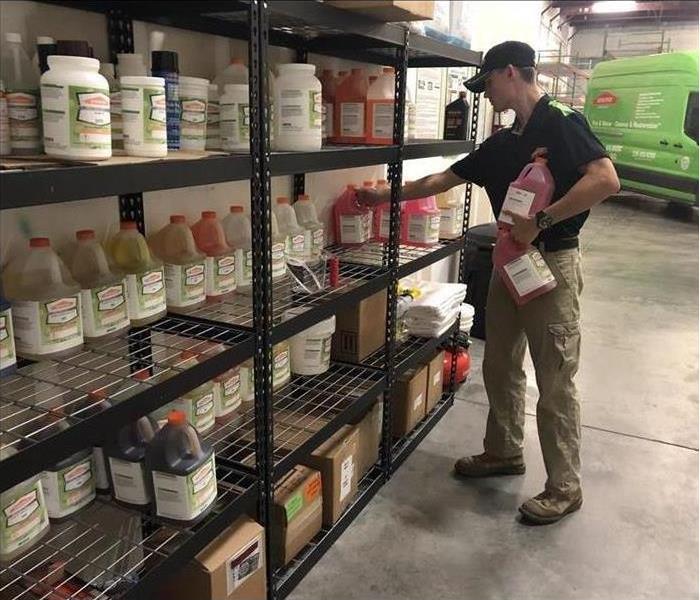 Proper cleaning supplies are crucial for storm preparation.
Proper cleaning supplies are crucial for storm preparation.
Cleaning Contents After a Flood
The damage of water to home furnishings and other valuables in your Village Walk, FL, residence after a flood can be devastating if you don't act immediately to protect them, so follow these tips when cleaning your valuables after a deluge.
1. Handle Photos and Other Valuable Documents With Care
Water in home and family keepsakes leaves them vulnerable to further damage. Photographs and other critical documents are particularly fragile, so handle them with care. Rely on document restoration specialists to repair these valuables. They have specialized equipment that can make your photos and other papers look as good as new.
2. Use Dry Cleaning Services to Preserve Heirloom Clothing
When heirloom clothing such as wedding dresses or antique military uniforms are damaged in a flood, take them to a professional cleaner to restore them.
3. Rinse Wet Items
When water from a broken pipe floods your home, you can gently clean items by rinsing them with a fine spray while they're still wet. Take care not to rub things, or you'll scratch the surface. Protect your skin by wearing latex gloves as your work with items.
4. Let Objects Air Dry Indoors
You don't want water in home furnishings to remain, but airing valuables outside in the sun could cause them to dry too quickly, increasing harm. If possible, let furnishings and other important items dry inside, so they suffer less damage.
5. Beware of Mold
When conditions are damp, mold can start to grow in just a few hours. Open your windows and set up fans so that the area can dry out as quickly as possible.
You don't have to lose your heirlooms and other precious valuables when flooding strikes your home. Following these tips and seeking help from professionals will save those items that you love and want to protect.
3 Tips To Prepare Your Business in Case of a Fire
5/14/2022 (Permalink)
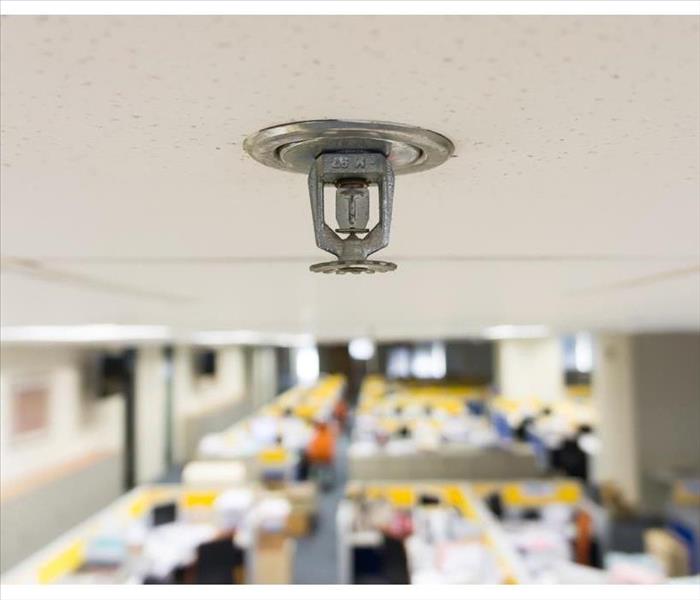 Install a fire sprinkler system in your business.
Install a fire sprinkler system in your business.
How To Practice Fire Safety
If you own a Quail West, FL, business, then you may have concerns about how to practice fire safety. From ensuring your employees and customers can evacuate your building safely to ensuring fire equipment is up to date, there are several ways you can prepare for a business fire and minimize the possible damage.
1. Make Fire Preparation a Priority
Creating a safety plan for your business means including steps employees can take in case of a fire. Elect a safety officer who inspects and maintains a section or floor and ensures all safety exits are clearly marked and clear of any obstructions. These officers can also maintain fire extinguishers for their floor and check the inspection dates at least once a year.
2. Maintain Storage
Depending on your city's laws and fire codes, you may have to properly maintain your company's storage and keep clutter to a minimum. Keep ceiling clearances clear and allow at least two feet of space between any items and the ceiling, especially in areas where you have sprinkler systems installed. A business fire may spread more quickly if the sprinklers do not work as they should because they are blocked.
3. Make Time for Safety Meetings
While you may have safety ideas for keeping the risk of fire damage to a minimum, they may not be as helpful unless you inform your employees about them. Hold safety meetings at least once a month and invite a business fire cleanup and mitigation service representative to your company to discuss the importance of fire safety. You can also encourage your employees to point out any possible fire risks they notice to your company's safety officer.
Preparing your Quail West, FL, business for a fire can help you feel more confident about how to handle such an emergency and keep everyone inside the building safe. From annual inspections to maintaining equipment, you can make your company's fire safety procedures a priority.
Flooded Basement: What is and Isn't Covered by Insurance
5/3/2022 (Permalink)
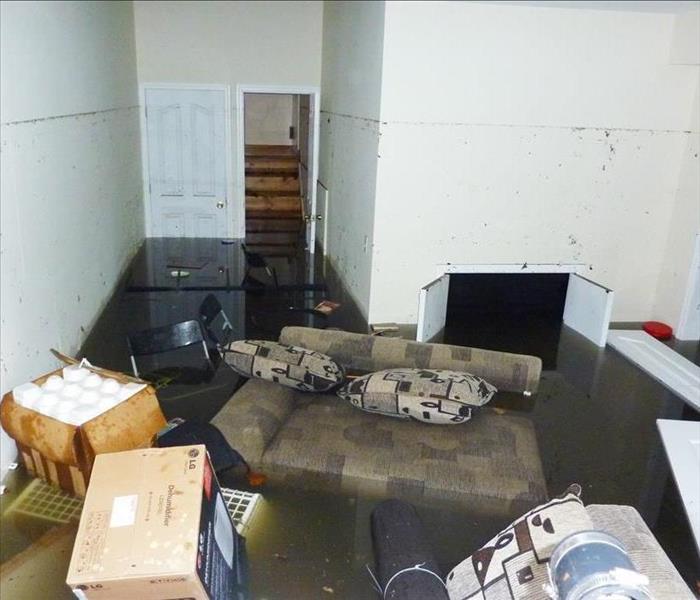 A flooded basement in Heritage Bay, FL.
A flooded basement in Heritage Bay, FL.
Flooded Basement
If you come home to find your Heritage Bay, FL, basement full of water, you know that your first call should be to your insurance agent. However, you might be surprised that not everything is covered by your policy. Here is a breakdown of what kind of damage is and isn't covered by insurance.
Replacing or Repairing the Cause of the Basement Flood
When you identify the source of the water in the basement, you might expect the insurance company to cover the repairs. However, most policies won't cover the cost of repairs for whatever caused the flood. For example, insurance policies won't cover:
- Broken pipes
- Washing machine supply hose leak
- Damaged water heater
- Leaking dishwasher
- Leaking roofing system
You may be able to purchase additional insurance coverage to cover a leaking sewer main and have that repaired at no cost to you.
Damage Caused by Flood Waters
Most standard homeowners policies don't come with flood insurance. So, regardless of whether your basement flood happened because of an intense rainstorm or an overflowing body of water, such as a river or lake, you won't be covered unless you purchase additional coverage.
A simple online search will tell you your risk factor for your home flooding. If you're at a moderate to high risk, you'll want to ensure that you always carry additional flood insurance.
Removing and Repairing Damaged Personal Property
Your insurance policy will replace and repair any personal property damaged in a basement flood. They will also pay to have a water damage repair service come in and make any repairs to the structure of your home so that it is safe to live in. Depending on your coverage, you might have a deductible and coverage limits to consider when organizing the repairs.
A flooded basement can be a major hassle but ensuring you have additional coverage and relying on the pros for clean up will have your space back to normal before you know it.
5 Simple Steps To Conduct a Workplace Fire Drill
4/26/2022 (Permalink)
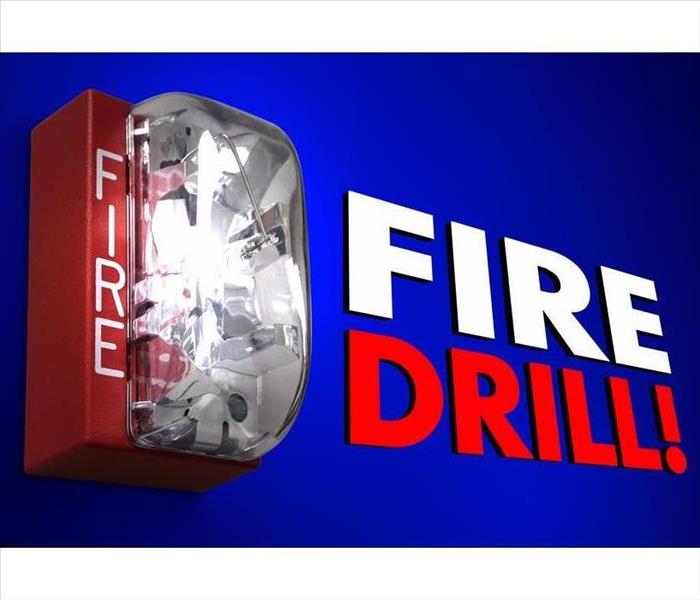 A fire drill is an essential part of your emergency planning.
A fire drill is an essential part of your emergency planning.
How to Run a Workplace Fire Drill
Due to the extreme danger that fires pose in the workplace, most businesses in Esplanade, FL, are required to take reasonable precautions to prepare for an emergency evacuation. This includes having an escape plan, running a fire drill and, in some cases, installing fire sprinklers.
As part of your evacuation plan, fire drills are essential. No matter how good planning is, practicing it at least once will help expose flaws that seemed logical during planning but fail in practice. Here are five steps to build an evacuation plan and run an evacuation drill.
1. Create a READY Profile
Your local storm damage restoration experts offer a no-cost facility assessment and a smartphone app that help you plan for emergencies. You can put all the useful information there to be ready at your fingertips when you really need it. It includes creating an Emergency READY Profile and making sure everything’s lined up with your insurance in case of disaster.
2. Prepare Your Evacuation Plan
This is also the best time to create maps of your inside that layout the best evacuation routes. These should be posted throughout your facility and will show the best escape route from each location. However, the maps should always list all possible escapes since the ideal route may be blocked.
3. Keep Key Employees Informed
Employees will be expected to guide customers and others outside. During a fire drill, they’re going to need to know the way outside by rote, since there’s a tendency to panic in a fire. They should know where the fire extinguishers are and where to assemble evacuees.
4. Announce the Drill
All employees should know well in advance of a planned first drill. Thereafter, it’s probably a good idea to run some without advanced notice. However, they should still know it’s a drill.
5. Conduct the Emergency Evacuation
Everyone should meet outside at the assembly point. Is anyone missing? Did an exit not work? This is your chance to find problems.
A fire drill is an essential part of your emergency planning. Even running a single test will pay dividends during a crisis.
Why Do I Need Emergency Board Up Service?
4/13/2022 (Permalink)
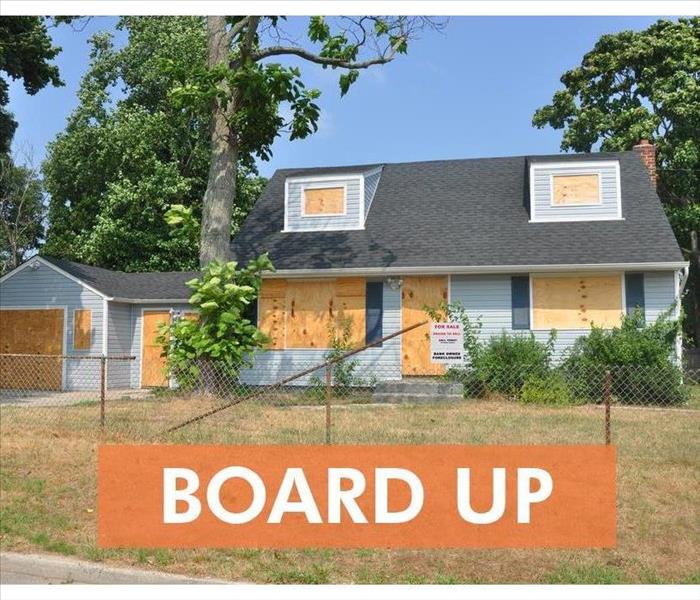 If your home has been damaged by fire, don’t underestimate the importance of prompt and professional board-up and tarp-over services.
If your home has been damaged by fire, don’t underestimate the importance of prompt and professional board-up and tarp-over services.
If your Quail Creek, FL, home is damaged in a fire or other disaster, the last thing you want to deal with is arranging for emergency board up or tarp over services. Most likely, you would rather take a “hands-off” approach, leaving everything up to your insurance company. After all, it can be extremely upsetting to view your home in such a state. Furthermore, it’s tempting to feel as though the damage has been done at this point — why bother taking protective action now? Read on to learn why failing to properly secure your home could have dire consequences.
What Are Board Ups and Why Do I Need Them?
After a fire or other disaster, your home may have structural damage which leaves it open to further damage from other sources. For example:
Exposure to the elements, such as wind and rain, could cause additional damage to your home, which in turn could dramatically increase your remediation costs.
Depending on the extent and nature of the fire damage, without proper board up service, you could face looters, thieves, or animal invaders.
Furthermore, many home insurance policies require that you take appropriate measures to secure your property pending repairs. Failure to do so could result in a loss of coverage.
Can I Do It Myself?
In the aftermath of fire damage, securing your home is a job best left to the professionals. While the property may appear safe, there may be indiscernible damage to your roof, floor, or load-bearing walls that can create unsafe conditions. Boarding up or tarping over damaged areas of your home is a service that is typically offered by premium restoration companies and some roofing professionals, who have the skills, equipment, and training to secure your property safely and correctly.
If your home has been damaged by fire, don’t underestimate the importance of prompt and professional board-up and tarp-over services to minimize your overall damage and reduce cleanup time.
What To Do if Your Basement Floods
4/5/2022 (Permalink)
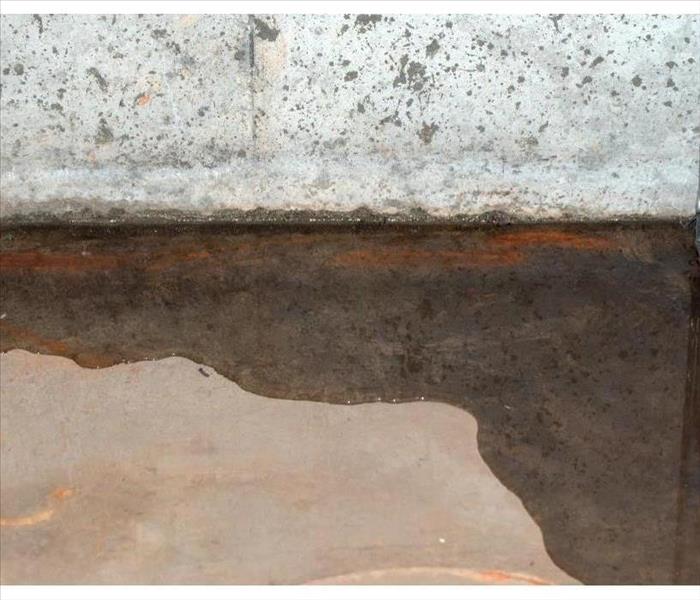 If you find a flooded basement you need to address the source quickly.
If you find a flooded basement you need to address the source quickly.
If Your Basement Floods Here's What You Should Do
Homeowners who experience a basement flood know they need to act quickly to reduce the amount of damage to their homes. After all, this space is probably being used to store more than just off-season decorations. Plus, taking quick action can get your insurance coverage to pay for more of the damage. Fortunately, there are a few steps that are guaranteed to help. Here is what you need to do if water enters your basement.
Find the Source
There are many reasons you would have a basement flood. Your first step is to find the source so you can report to your insurance agent and chosen water restoration company. The most common sources include:
- Natural disasters
- Groundwater seepage
- Sewer backups
- Malfunctioning appliances
- Drain clogs
Turn Off Your Water Supply
You can fix most internal sources by turning off your water supply. The shutoff valve will be located somewhere in or around your house. Usually, it will be in your basement along the wall facing the street. If water is leaking from one of your appliances, you can turn the valve leading to that fixture off. Older homes may not have this feature.
Check Your Sump Pump
In the event of a basement flood, you need to check that your sump pump is working. If you're not sure if it's working, unplug it and let it rest for a few seconds. If it doesn't start working immediately when you turn it back on, buy a new one and replace it.
Check the Floor Drain
If water is coming in through your floor drain, the sewer system in Olde Cypress, FL, could be backed up or your drain is clogged. When your drain is clogged, and water is coming in from another source, you need to unclog it as soon as possible. If the sewer system is backing up, you need to notify the city and call a plumber.
When you go downstairs and find a flooded basement, you need quickly find and address the source. Then, you need to check your drainage measures to make sure they are working.
How To Prevent and Handle Mold Contamination
3/29/2022 (Permalink)
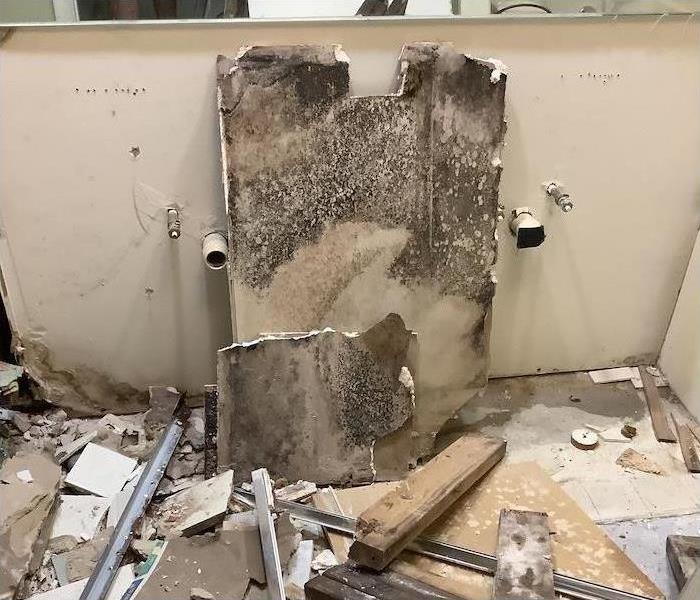 Mold restoration in Island Walk, FL.
Mold restoration in Island Walk, FL.
Mold Containment and Cleanup Process
Finding mold in your building is a serious matter in Island Walk, FL, and leaving it unattended and untreated is a big mistake. When it comes to mold cleanup and restoring your business, it is important to take the appropriate steps to prevent mold from spreading to other areas of your building. If you do not take measures to prevent cross contamination, your mold situation could get out of hand quickly and lead to costly damage.
There are several steps in the mold containment and cleanup process, including:
- Isolating the affected area
- Cutting off air flow
- Creating negative pressure
- Removing mold and damage
- Restoring the building
Containment
Isolating the mold colony is important for limiting fungal spread. Sealing windows and doors, covering air vents, and using physical barriers are effective ways to keep the growth from creeping into other parts of the building. Shutting off air flow and creating negative pressure keeps mold spores from becoming airborne and traveling to other surfaces and rooms.
Mold Removal
Once the area is sealed off and the air from the contaminated area has been removed, you can begin the mold removal process. You should treat all infested areas with antimicrobial and antibacterial solutions and discard any items that are damaged by the mold. Enlisting the help of professional mold cleanup and remediation services will ensure the infestation has been removed completely and the risk of additional mold contamination has been eliminated.
Restoration
After removing the mold, you can begin restoring your building. This process can include minor repairs, such as putting fresh paint on walls and replacing carpets. However, in more severe cases, some parts of your building may require reconstruction.
It is important to understand the different steps in the remediation process to take effective action against a mold infestation. Starting the mold cleanup process as soon as you spot the problem can save your business from suffering major damage and costly repairs.
What Happens To Your Electronics After a Fire?
3/14/2022 (Permalink)
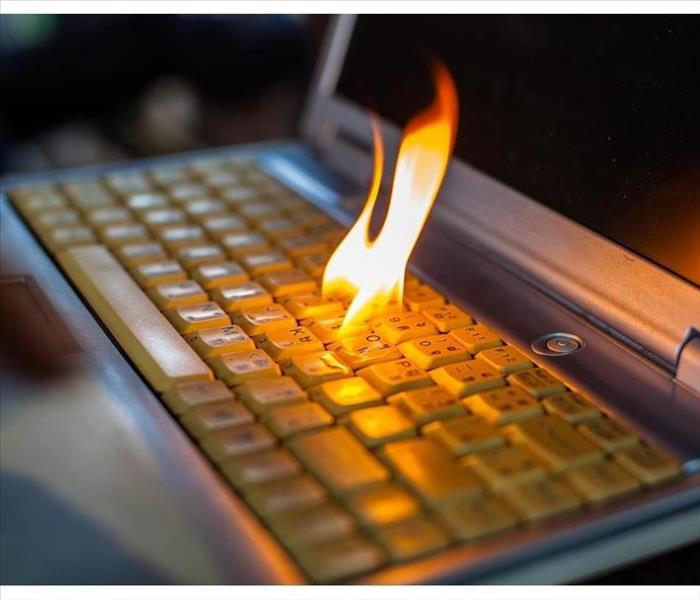 Do what you can to keep your electronics in working order.
Do what you can to keep your electronics in working order.
After a fire, What Happens to Your Electronics?
Whether you've experienced a kitchen fire or an electrical fire, the contents of your commercial property have most likely been affected in some way. This includes electronics like computers, printers and televisions. If you're in Vineyards, FL, what can you do about it?
What's the damage?
While fire itself is probably the most obviously damaging to its surroundings, more insidious side effects like smoke damage can be almost as harmful, and more pervasive. Smoke is airborne so it can reach almost any surface. Unfortunately, soot can cause electronics and appliances to malfunction. Some common resulting issues are:
- part degradation, because soot is acidic
- shorted circuits, because smoke has a magnetic charge
- overheating, because of the insulating effect of the black film left behind by smoke
Are They Salvageable?
Unless your machine was part of an electrical fire itself, the answer is most likely yes. Before taking any further action, you should shut off and unplug all electronics and appliances present. In the case of a computer, try and remove any hard drives or memory. If possible, transfer what you can to an undamaged computer or storage space.
Can You Do It Yourself?
Due to the complex nature of digital machines and the specificity of the situation, you are better off calling a professional remediation service for your computer cleanup job. This is especially true if you have a large number of electronic assets. These types of items are valuable, so it is in your best interest to ensure that they are not damaged further through ignorance. In the proper hands, your appliances could be as good as new.
If you've managed to come out the other side of an electrical fire, you are probably looking to continue to run your business while you rebuild. In order to do that, you shouldn't forget about smoke damage and do what you can to keep your electronics in working order. Computers need love, too!
Why Do Insurers and Clients Prefer SERVPRO?
3/5/2022 (Permalink)
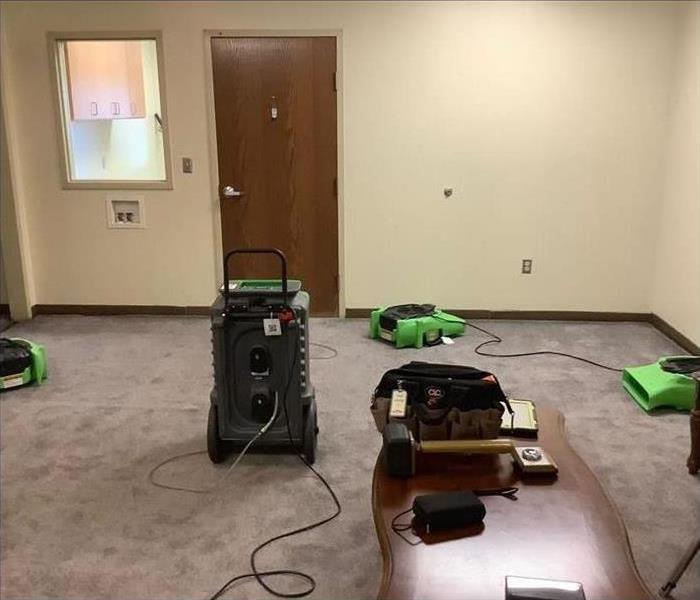 Choose SERVPRO of East Naples when restoring residential damage.
Choose SERVPRO of East Naples when restoring residential damage.
Why Choose SERVPRO?
Most insurance companies have Preferred Vendor networks for cleaning and restoring property damage. An insurance adjuster may recommend contacting a particular service, or homeowners may want to obtain an estimate from a reputable company when making an insurance claim. Insurers and clients prefer SERVPRO, an all-in-one mitigation and restoration service, for several reasons.
Faster Responses
A national company with local franchises can respond quickly, even in the event of a large-scale loss. There are several reasons why this is the case:
- A centralized call center
- Local locations
- The ability to rely on backup locations
Each franchisee must abide by 21 guidelines in order to receive Insurance Client referrals. Insurers appreciate this level of quality assurance.
Trained Professionals
An insurance adjuster or a homeowner should seek out service with mitigation and restoration expertise. SERVPRO offers several types of training:
- New franchise training
- Employee training
- IICRC credentials
- Continuing education
Taken together, all of these programs enable employees to stay current with the leading mitigation and restoration methods for every type of damage. This allows for faster and more complete jobs and lower claim amounts.
Accurate Assessments and Estimates
Trained professionals at an all-in-one cleanup and restoration company are also capable of providing a complete assessment and arriving at a more accurate estimate. Estimates should take into account the types of equipment and expertise required, as well as the duration of a mitigation and restoration job.
Electronic Services
Agents and adjusters are also likely to appreciate the Claims Information Center. This electronic service allows insurance representatives to access estimates and collected data from across the country all the way down to the state, county or local level.
All of these factors combine to make a Preferred Vendor the best option for restoring residential damage in Golden Gate, FL. Whether you are a homeowner or an insurance adjuster, you should contact the nearest SERVPRO franchise.
Prevent Flooding Caused by Frozen Pipes
2/28/2022 (Permalink)
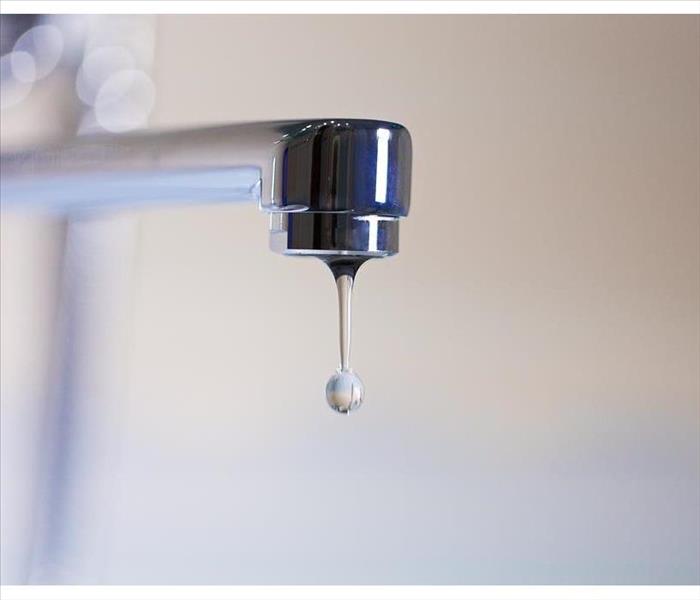 Let water drip.
Let water drip.
Frigid winter months can bring significant problems to commercial buildings in East Naples, FL, from ice dams that cause roof leaks to burst pipes. As water freezes, it expands, putting pressure on its container. This container, whether plastic or metal, may not be able to hold it. When the container is a pipe, it may burst, causing standing water and damage to the surrounding area. However, there are steps that can be taken to minimize the risk of a burst pipe.
Why Pipes Burst
Although the most basic explanation for pipes freezing is cold weather, it’s not quite that simple. There are other contributing factors, which can include:
- They have inadequate or no insulation.
- They are in cold or exposed areas in or around the building.
- There is water sitting in the pipes instead of circulating through them.
When Pipes Freeze
Depending on the building and usage, frozen pipes may be a minor inconvenience or a catastrophic event. The consequences of a burst pipe can include:
• No access to water or use of drainage pipes
• Irrevocable pipe damage, which requires that the pipes are repaired before they can be used
• Water damage that may be limited to drips or result in flooding areas of the building
How To Prevent Pipe Bursts
Taking some time during the warmer months can help prevent a frozen pipe during the winter season.
- Insulate exterior pipes and those located in unheated areas, such as basements or crawl spaces.
- Let water drip, allowing it to run and prevent pressure from building, which can cause a burst pipe.
- Check shutoff valves and levers, ensuring they are in good working condition.
- Keep heat and water on in areas of the building that are not in use.
If a water event does occur, water restoration professionals in East Naples, FL, restore your premises to their former condition, “Like it never even happened,” allowing you to get on with business as usual.
Trust SERVPRO and Its Fire Restoration Process
2/27/2022 (Permalink)
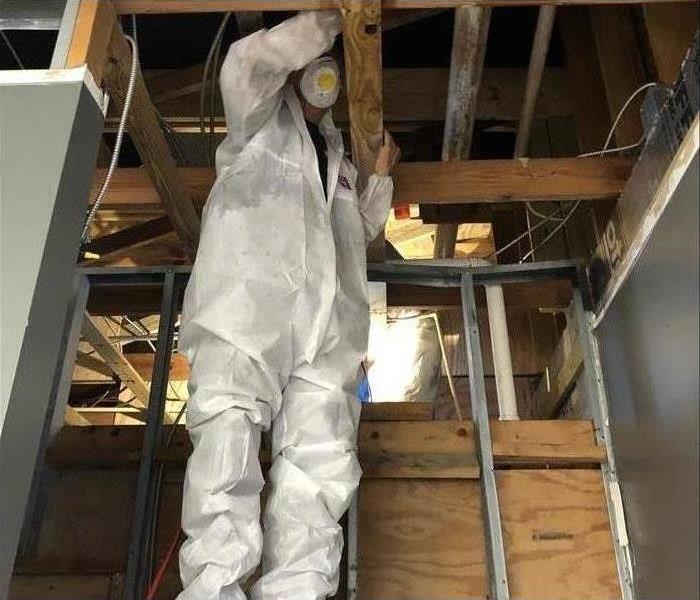 Fire restoration in Village Walk, FL.
Fire restoration in Village Walk, FL.
SERVPRO's Fire Restoration Process
If a fire starts in your Village Walk, FL, home, you know it’s vital to get out safely and call the fire department as soon as possible. If the fire was extensive and ruined or damaged parts of the structure or your belongings, you need an experienced fire restoration team to help. The best companies have qualified professionals who will follow thorough steps to help ensure you get back on your feet soon.
Tried and True Steps
There are many benefits to enlisting the talents of a fire cleanup company. When you get SERVPRO on the case, you can have confidence that the employees will follow the most effective process to salvage or replace those items the fire affected. These key steps are as follows:
- Inspect and evaluate
- Tear out, tarp and board
- Clean and sanitize
- Replace, if necessary
Inspection
The first thing the team will do is complete a thorough, meticulous inspection to assess the extent of the damage. Technicians will come up with a plan of attack based on how much of the home suffered damage, what portions of the home and what items need attention, and what they can salvage and what they must replace using rebuilding services.
Tear-Out and Boarding Process
If fire and smoke completely ruined areas beyond repair, the team will remove these items to prevent further problems. Company representatives will also mitigate holes and gaps in the roof or walls by boarding up and tarping the problematic places.
Cleaning and Sanitizing
Smoke damage can make fire restoration difficult, but SERVPRO has the necessary equipment and methods to clean just about anything, including electronics. The team will do its part to make your home livable once more.
Restoration
In a fire rebuild, SERVPRO will repair and restore drywall, flooring, roofs and other places that the fire ruined. The team will replace items as the last resort.
For your fire restoration needs, trust SERVPRO. The team has what it takes to ensure a successful repair and rebuild of your home.
3 Important Tips for Safely Using Your Space Heater
2/22/2022 (Permalink)
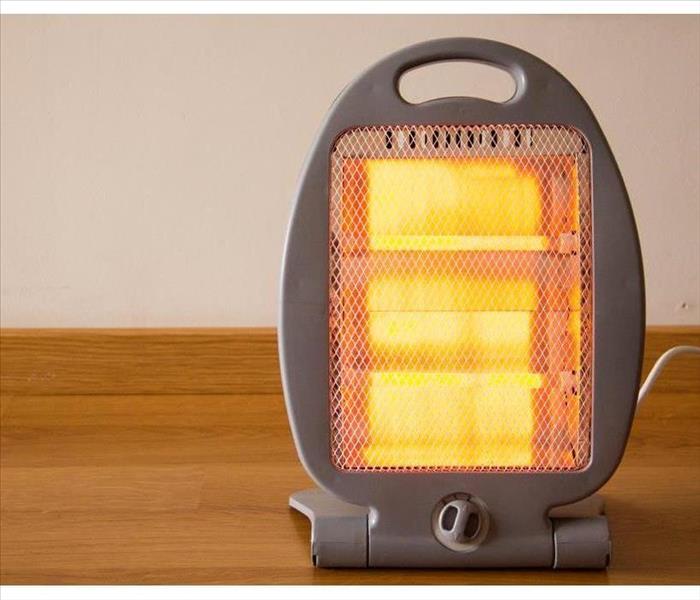 Don’t leave your space heater unattended!
Don’t leave your space heater unattended!
Three Crucial Points to Keep in Mind When Using Your Space Heater
Although space heaters are great for adding some extra warmth to your home in Quail Creek, FL, when they are misused or not properly maintained, a burned space heater fire can occur. Although a fire restoration company can help with smoke cleanup and reconstruct your home if a fire does occur, taking some simple precautions can reduce the chance you will need to make a call in the first place. Always remember to adhere to these three tips whenever you decide to pull out your space heater.
1. Place the Space Heater on a Stable Surface Away From Flammable Objects
Place your space heater on a hard surface, like the floor, to avoid having it fall down and catch on fire. It is also very important that you don’t let flammable objects like blankets, curtains, towels, and clothing be within three feet of the heater. Also, keep your heater as far as way as possible from gas cans, paint, or matches.
2. Take Good Care of the Electrical Components
Never plug your heater into an extension cord or an outlet that’s already being used. This can quickly lead to a burned space heater. Also, regularly inspect your heater’s electrical components, including the cord, to observe for any damage. When unplugging, pull the plug straight out instead of pulling on the cord.
3. Be Very Wary of Running Children and Curious Pets
If your pet or children were to accidentally bump into the space heater while running around or playing, a fire could quickly occur right next to them. Pets won’t understand the danger associated with the heater and are better left outside the room. Instruct your child to stay at least three feet away from the heater and never put one in a child’s bedroom.
These three tips are important to remember for preventing a fire caused by a burned space heater! Don’t leave your space heater unattended, and make sure there is no hazards insight every time you use it.
Building Envelopes Eliminate Moisture Problems Due to Rain
1/31/2022 (Permalink)
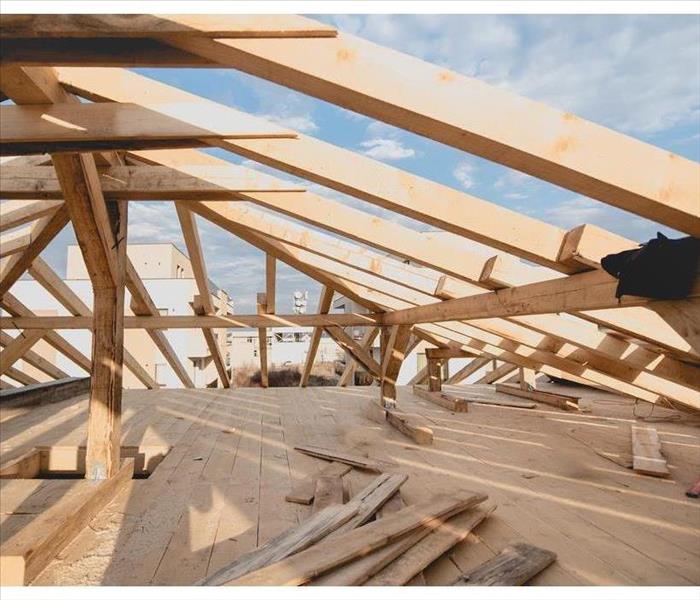 There are many good reasons for implementing building envelopes.
There are many good reasons for implementing building envelopes.
You’ve Never Heard Of a Building Envelope?
Imagine surrounding your entire business space with insulation and a vapor barrier. That’s an envelope. It has several characteristics:
- Insulation surrounds the space and keeps the temperature at the desired level
- A vapor barrier surrounds the space and keeps rainwater out
- Rain damage cannot occur inside the envelope
- Rain cannot cause black mold inside the envelope
- Any area of the structure outside the envelope is susceptible to water damage
Building Envelopes Are Most Effective in New Construction
The concept is most effective when the entire structure is inside the envelope. Retrofitting envelopes to existing structures is a challenge. It is difficult for them to achieve a comparable level of protection against rain. External portions of the retrofitted structure may still be susceptible to rain damage.
A Properly Implemented Envelope Keeps Moisture Levels Low During Storms
Control is important if the business processes demand low levels of humidity. It is also important when circumstances require more moderate levels of moisture. Set the humidity to any level and weather won't affect it.
Remember That Rain Is Not the Only Source of Moisture
Envelopes are an excellent way to limit inside moisture due to rain. However, remember that they will not solve all moisture problems. You have restrooms. You may have kitchen areas and laboratories. You have sprinklers as part of your fire suppression system. Any of these can make a rain-caused moisture problem look trivial. There are many good reasons for implementing building envelopes. Just don’t expect it to be a cure-all for moisture problems.
Your building envelope helped you avoid rain damage, but water never gives up. It always finds a way to cause trouble. When you end up with water damage, the best response is to deal with it immediately. Otherwise, you may encounter that black mold that you hoped to avoid. Skilled water remediation professionals are in the Olde Cypress, FL, area. They are ready to handle your problem and are a phone call away.
Are Home Mold Testing Kits Accurate?
1/30/2022 (Permalink)
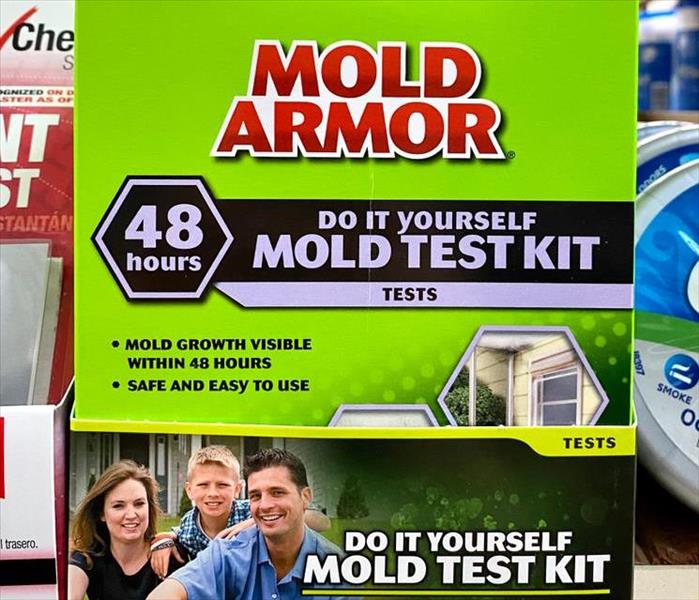 Most home mold tests are not precise enough to identify the species of mold.
Most home mold tests are not precise enough to identify the species of mold.
Are Mold Testing Kits at Home Reliable?
Homeowners may consider using home mold testing kits due to the comparatively low cost of these tests relative to professional testing and analysis. There are several reasons why expert testing is more accurate and useful. Learn more about the shortcomings of DIY mold tests and why it is worth it to seek the services of a certified environmental hygienist or full-service mold restoration company in Island Walk, FL.
False Positives
Home mold tests vary insensitivity. Many tests are prone to return positive results for several reasons:
- Mold spores are everywhere
- Some kits are not properly calibrated
- Results may be ambiguous
A home mold testing kit may react to the presence of spores without factoring in whether microbial volatile organic compounds are present. These off-gases are released during the active growth cycle of fungi and indicate that mold is actively growing.
Inaccurate Species Identification
Most home mold tests are not precise enough to identify the species of mold. It is not possible to make a positive identification based on color. Black mold or Stachybotrys is actually dark green early in the growth cycle. As there are more than 100,000 known species of mold, lab testing is necessary to obtain an accurate identification.
No Expert Opinions
Environmental hygienists and mold specialists can offer informed opinions throughout the professional testing and remediation process. Insight into the following factors may be helpful:
- The location of mold growth
- Potential causes
- Whether a species of mold is toxigenic
All of these factors will impact the type of cleaning methods and equipment necessary to remediate mold damage. Remediation may be more affordable and successful if expert knowledge is available.
A home mold kit may be affordable in Island Walk, FL, but it is unlikely to be as accurate as professional testing. Homeowners should put the money they might spend on attempts at DIY mold tests toward expert mold testing and remediation that can fix the problem “Like it never even happened.”
How To Address Kitchen Sink Leaks
1/24/2022 (Permalink)
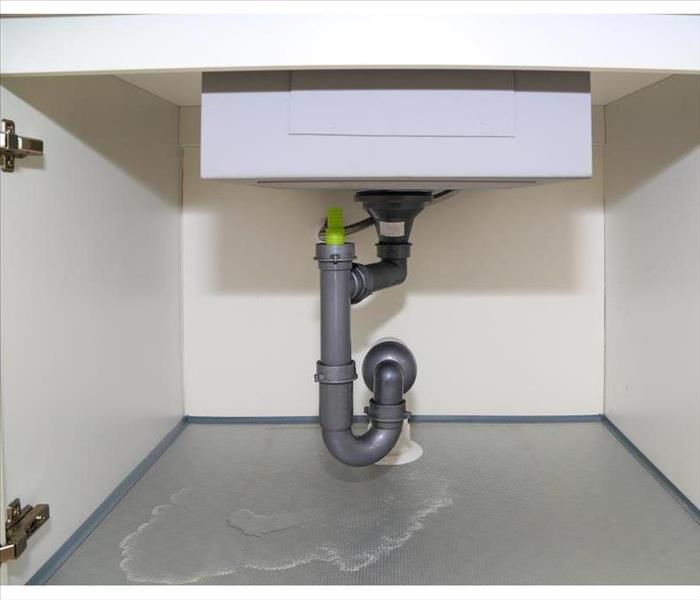 Kitchen sink leaking in Golden Gate, FL.
Kitchen sink leaking in Golden Gate, FL.
What To Do If Your Kitchen Sink Is Leaking
It’s not uncommon for a homeowner in Golden Gate, FL, to contend with flooding issues or other water problems. One of the most likely places to find leaks is under the kitchen sink. These issues can develop over time and slowly occur without your immediate detection. They may also start suddenly due to a burst pipe or plumbing malfunction. If you can effectively respond to these situations, you can avoid disasters and costly cleanup.
Crucial Steps To Take
Once you realize you’ve got water in your home, you need to act appropriately and swiftly so you can minimize damage and remedy the problem. Here are your initial steps when you find a leak under your kitchen sink:
- Find the exact source of the problem
- Shut off the water flow to the sink.
- Call a professional plumber
Find the source
The faster you can determine where the leak originates, the better chance you have of avoiding major flooding. When it comes to leaks in the kitchen sink, there are a few usual suspects. The problem could reside at the valve or supply line, which will be under the sink near or against the wall. If the leak isn’t come from there, it could be a problem with the drain or with the faucet base.
Shut Off the Water
Once you’re confident you know where the leak is coming from, you need to turn off the water so you can put an end to the leaking. It should be simple enough to turn the shutoff knob, but if for some reason it won’t turn easily, you can shut off the main water line to your home.
Call a Pro
Luckily, if severe flooding requires total kitchen repair, you can call a licensed restoration crew to help. Before it gets to this point, you can avoid severe problems and contact a plumber to help you put an end to the leak and get your sink in proper working order once more.
Kitchen sink leaks are annoying, but they’re usually easy to address. Follow these steps and enlist the expertise of plumber, and you shouldn’t have to worry about flooding in your kitchen.
How To Perform First Aid After a Fire
1/19/2022 (Permalink)
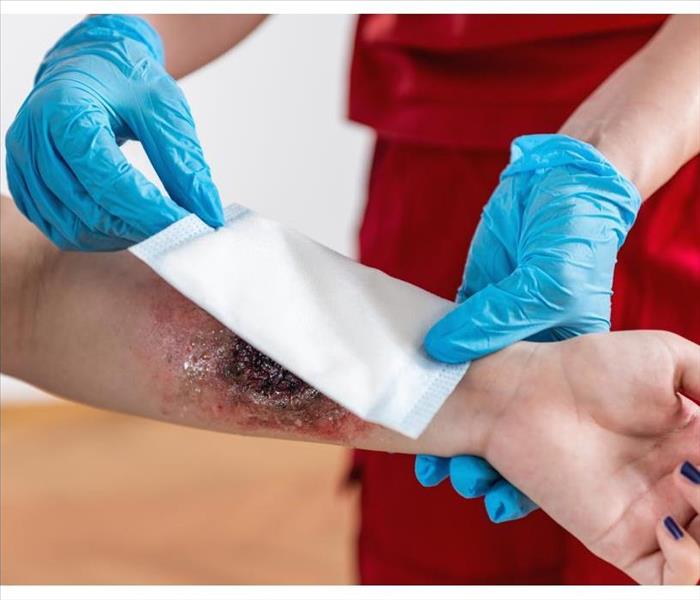 Prepare yourself by learning how to administer first aid if a coworker has been burned by a fire.
Prepare yourself by learning how to administer first aid if a coworker has been burned by a fire.
How To Administer First Aid
No place is untouchable from fires. Even established business areas in East Naples, FL, can be at risk. Your workplace should have a plan for building evacuation, as well as a plan for fire damage recovery and restoration. However, you can also prepare yourself by learning how to administer first aid if a coworker has been burned by a fire. Here are the steps you should take if such an event occurs.
1. Prevent Further Injury
If the person is near the source of the fire damage, assess if it is safe to move toward him or her. If it is safe, clear away anything touching the person that may have caused the burn.
2. Examine the Injury
See if the person is still conscious. Establish if it is a major burn by looking for these symptoms:
- The burn is either very deep into the skin or at least three inches in length.
- The area is a major body part such as the face, hands or feet.
- The skin is charred, leathery, or covered with dark-colored patches.
3. Get Help
If the person is in critical condition and cannot be transported to get care, call 911 immediately and explain the person’s condition to the 911 operator. Follow any instructions and stay with the injured person until help comes.
4. Apply Burn First Aid
You can temporarily treat the person’s wound while you wait for help to arrive. If he or she has a major burn, carefully remove items wrapped around the burned area such as jewelry. Keep it clean by applying a clean cloth or bandage. You can also moisten the covering with cool water to alleviate the pain.
Witnessing fire damage at your workplace can be devastating, but being calm and taking care of anyone injured can minimize the most harmful effects of a fire.






 24/7 Emergency Service
24/7 Emergency Service
































